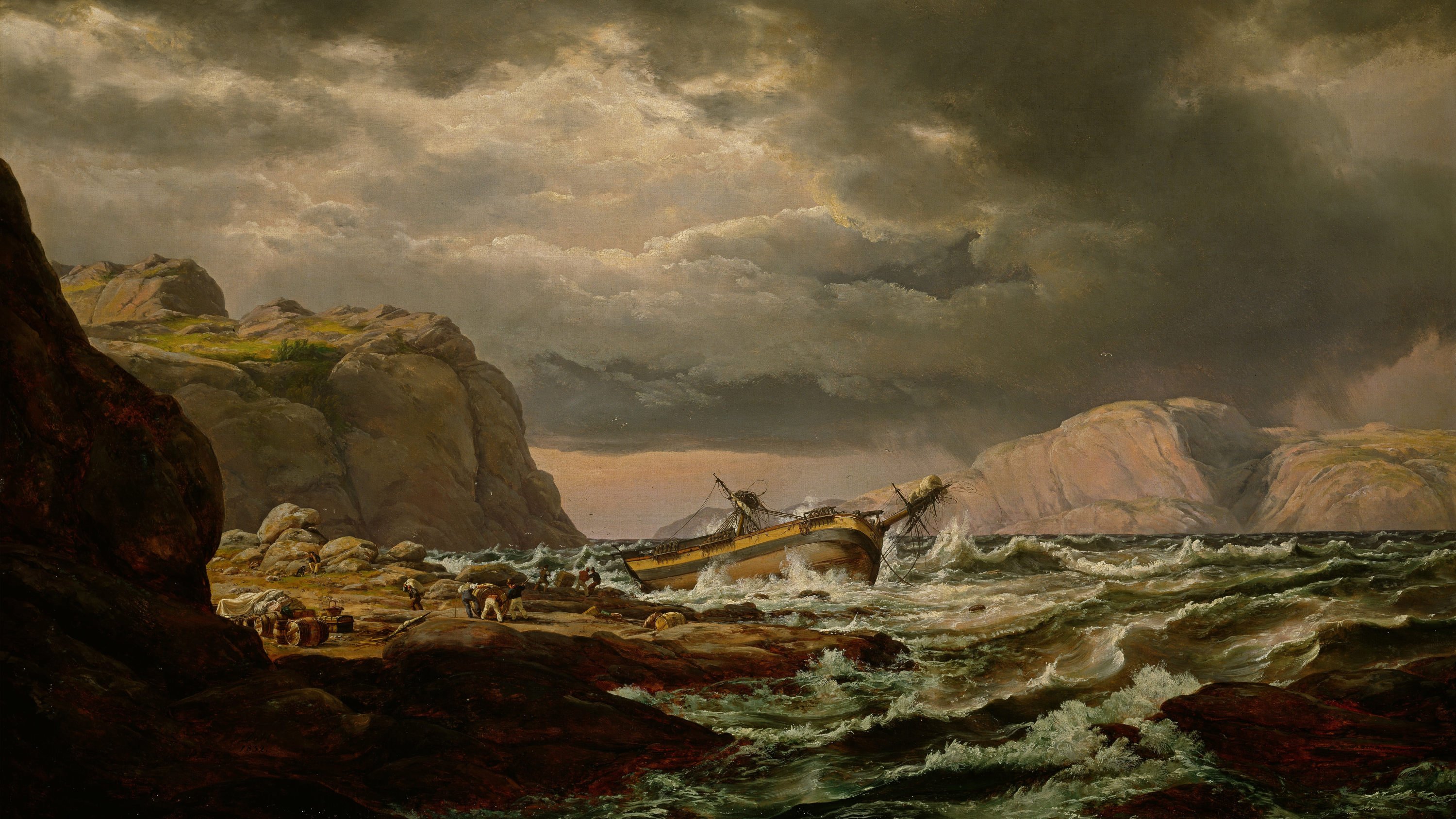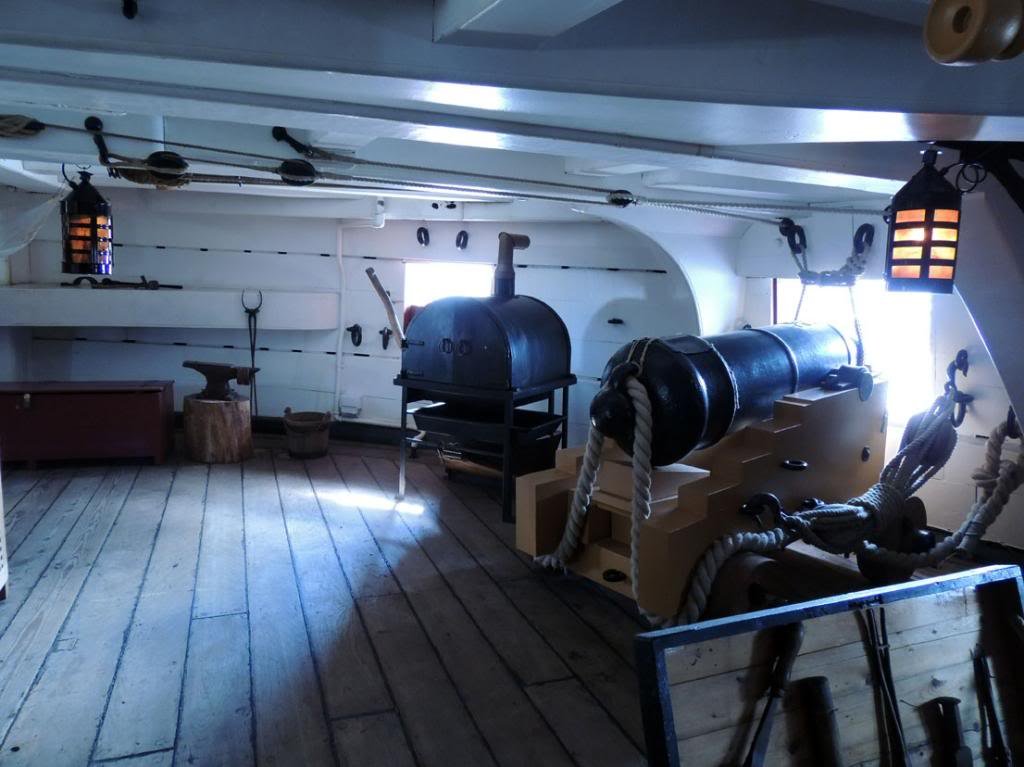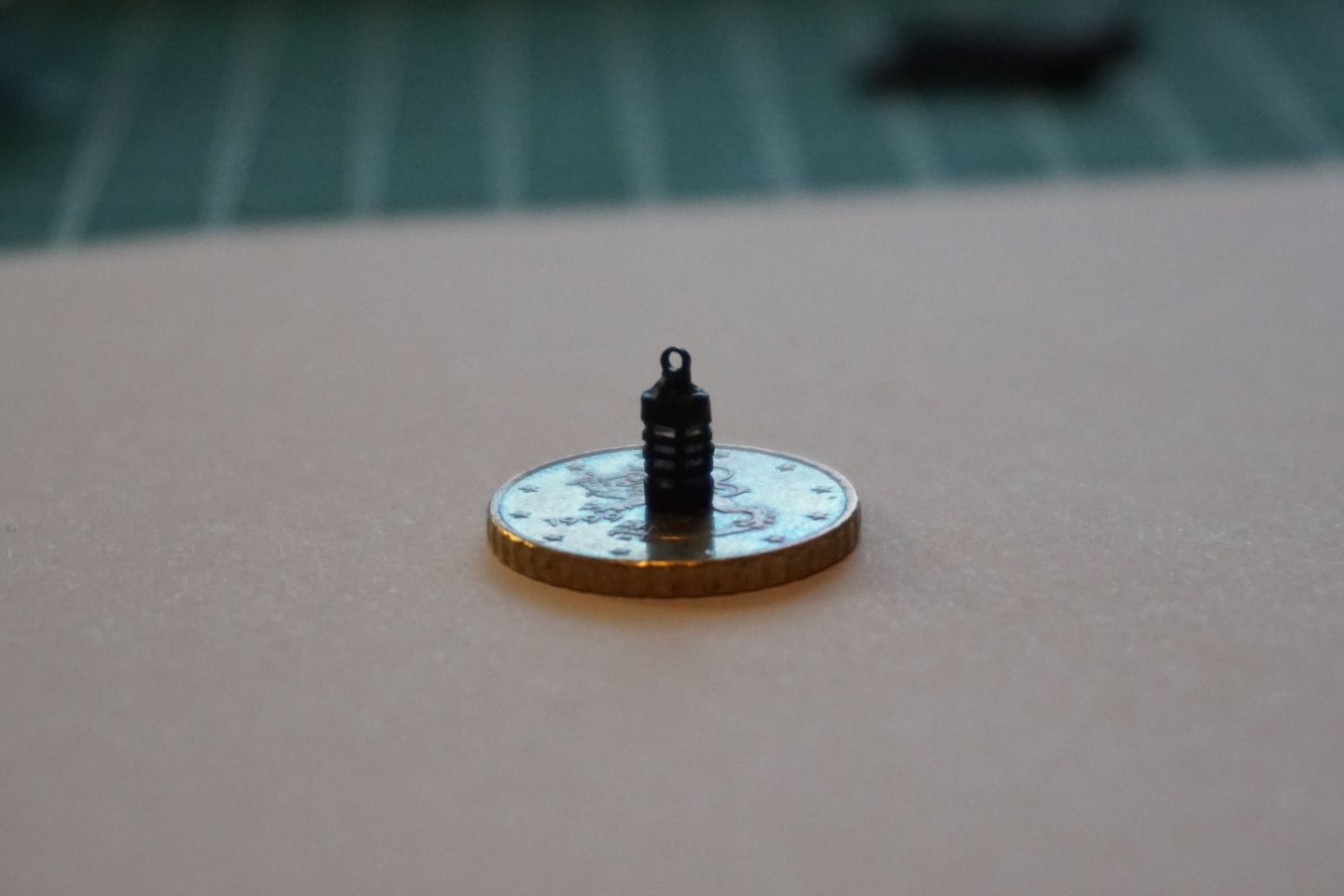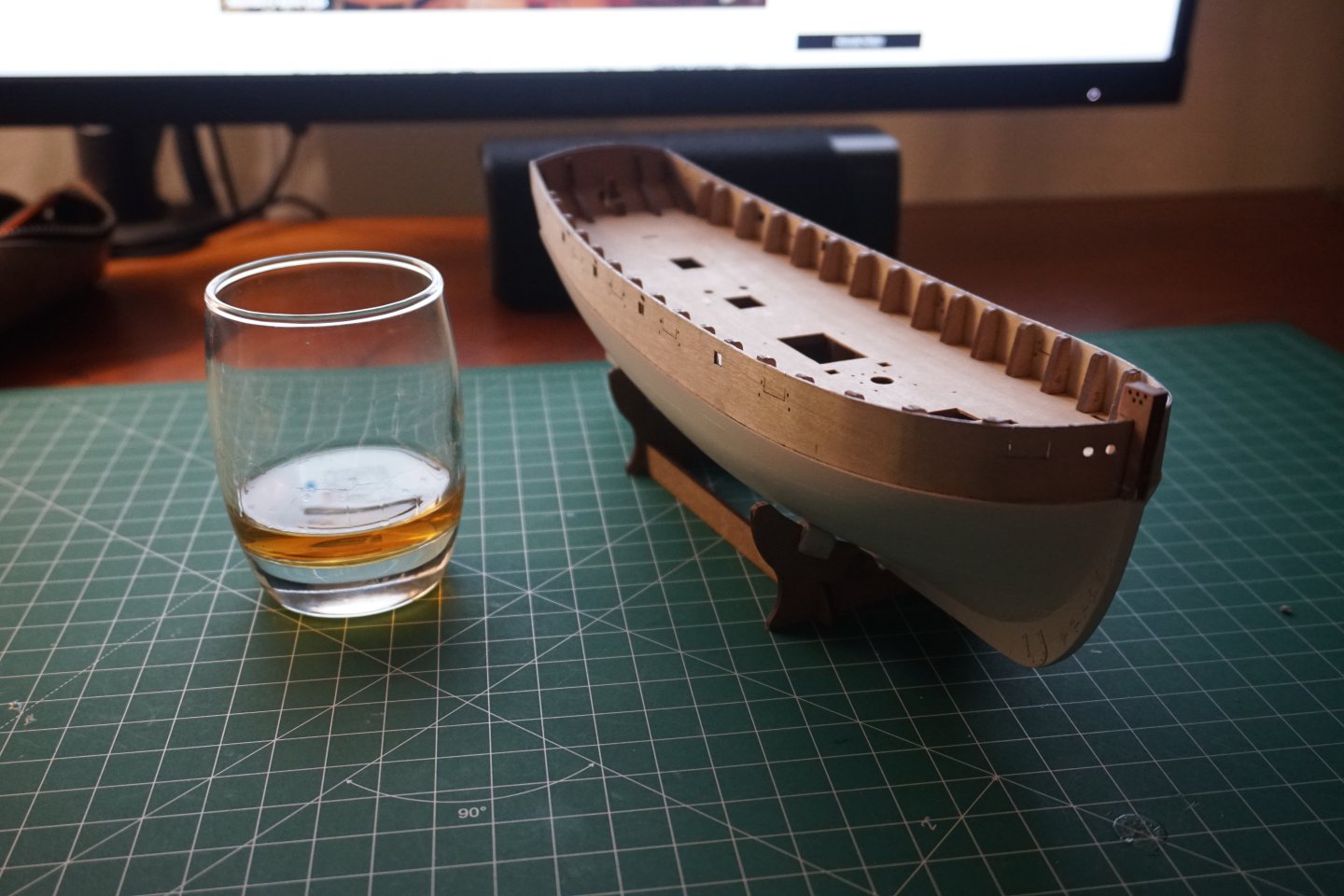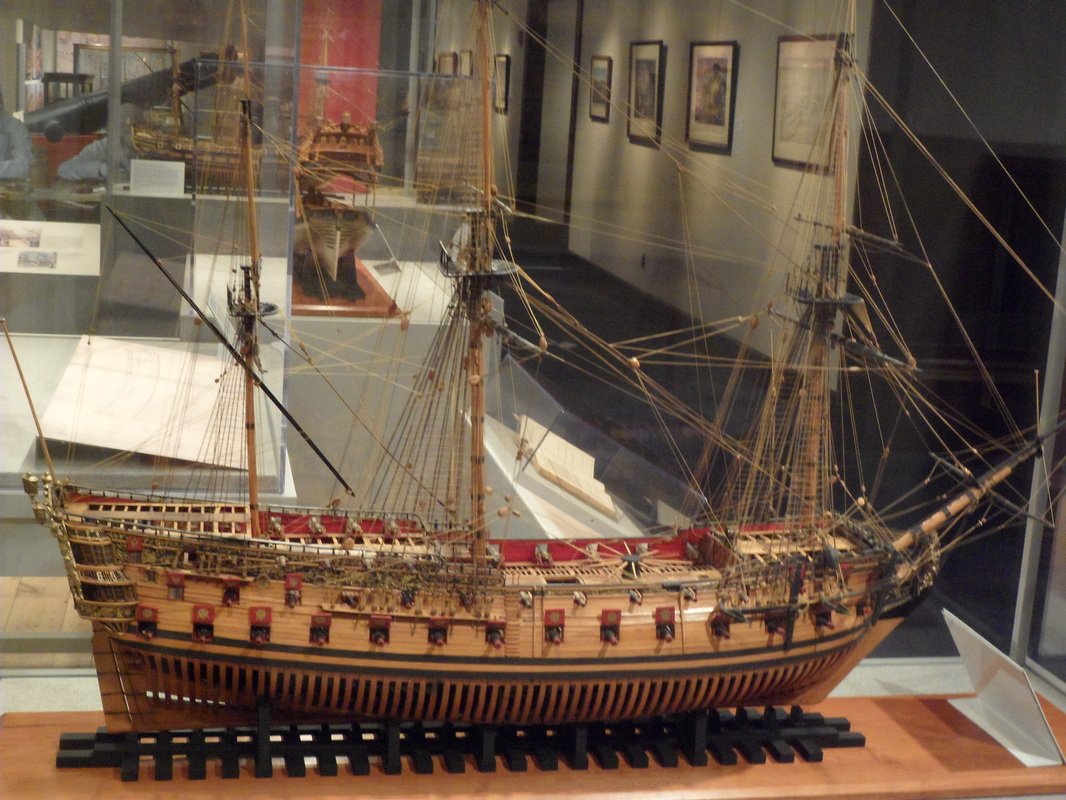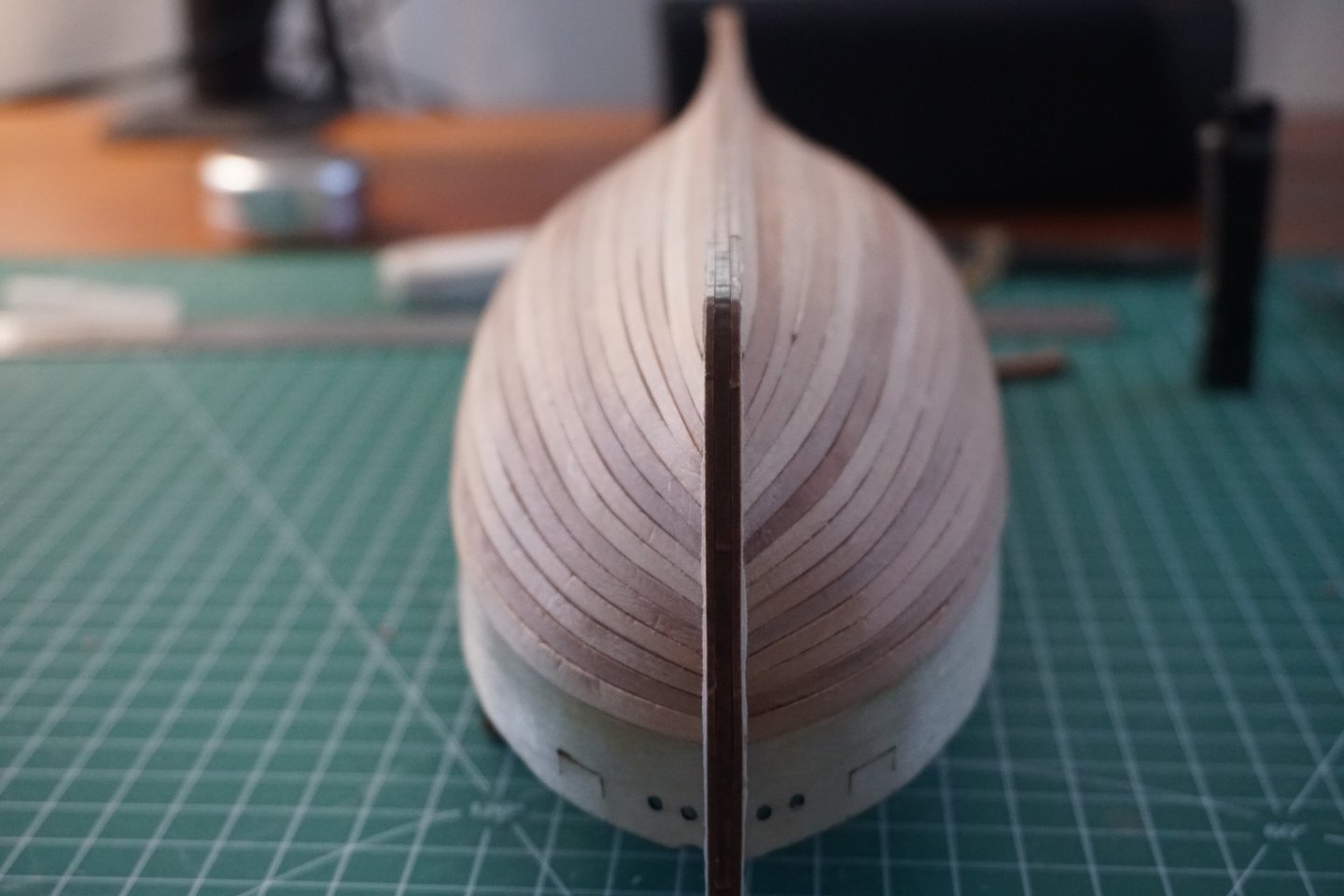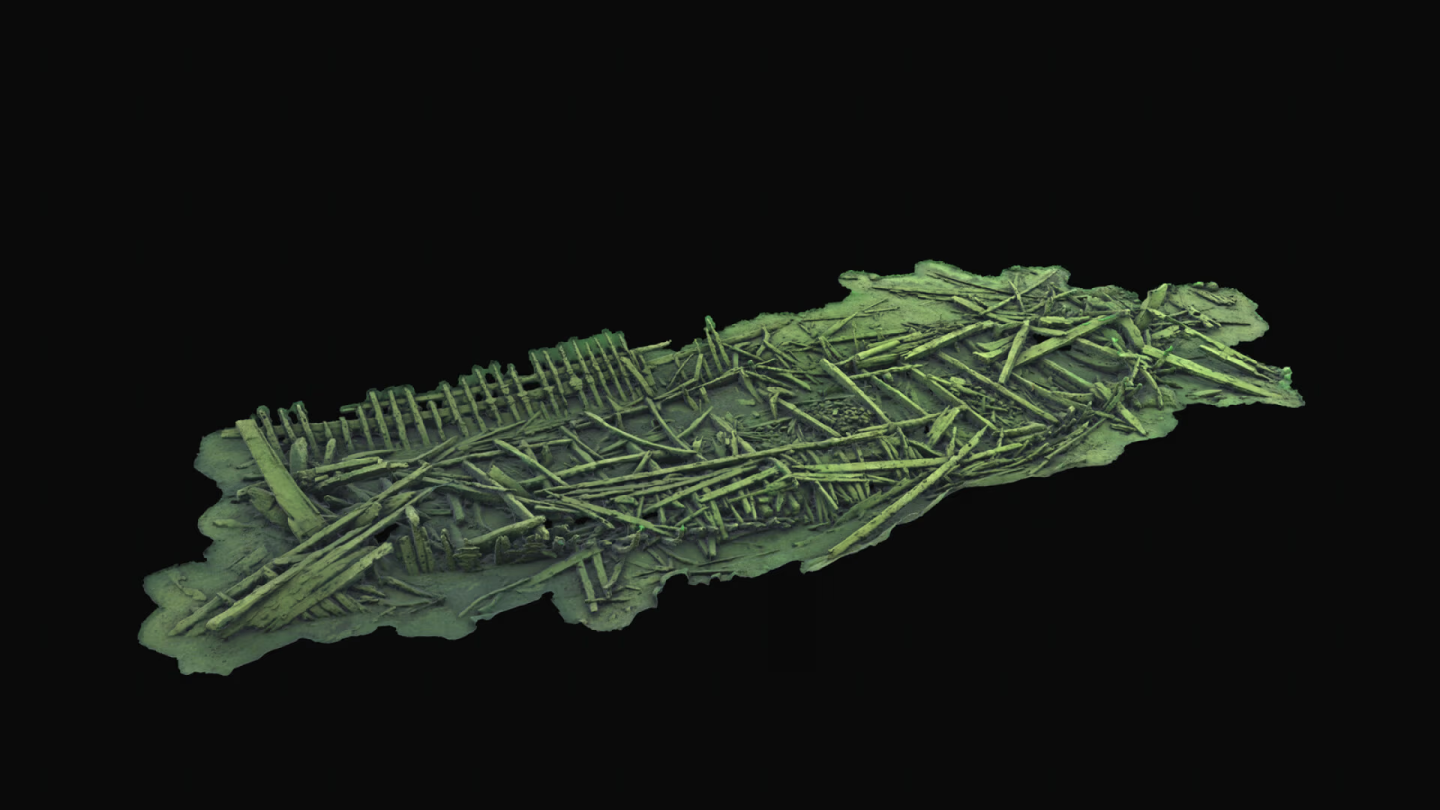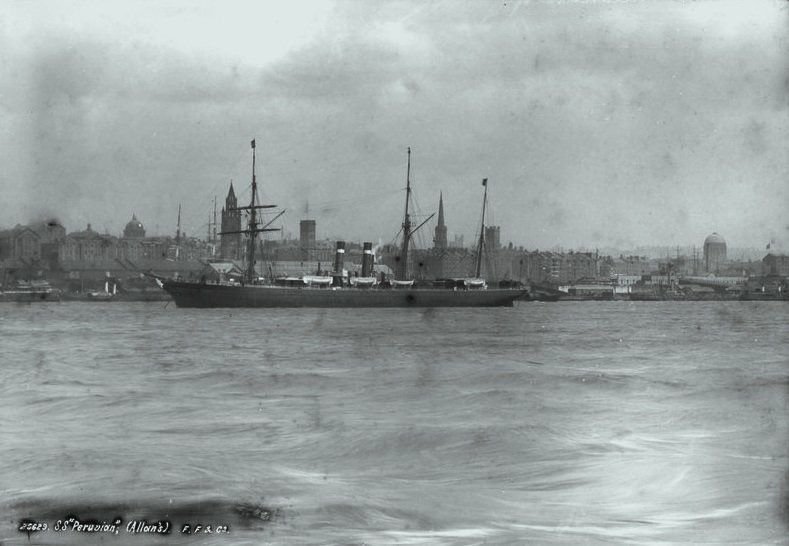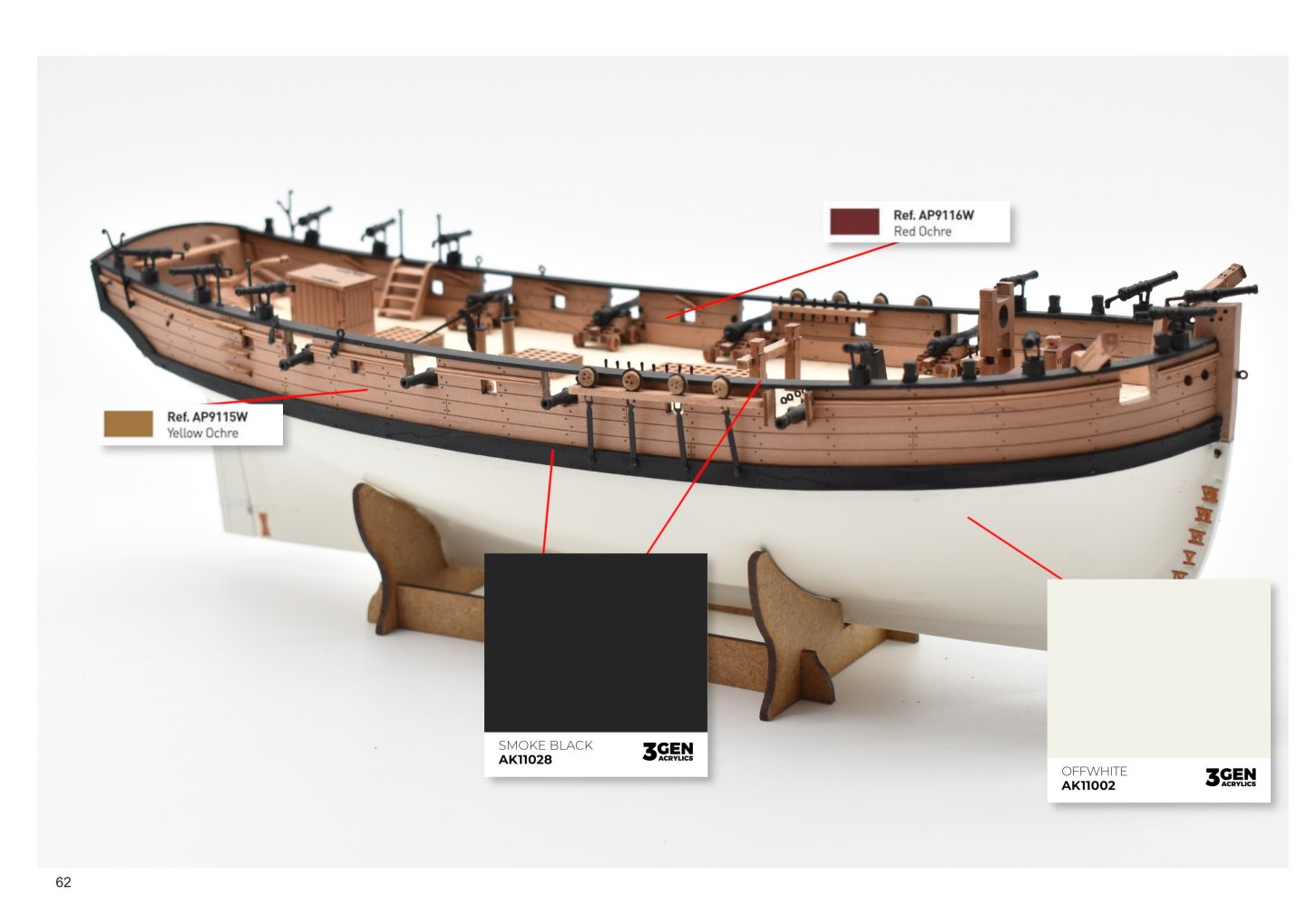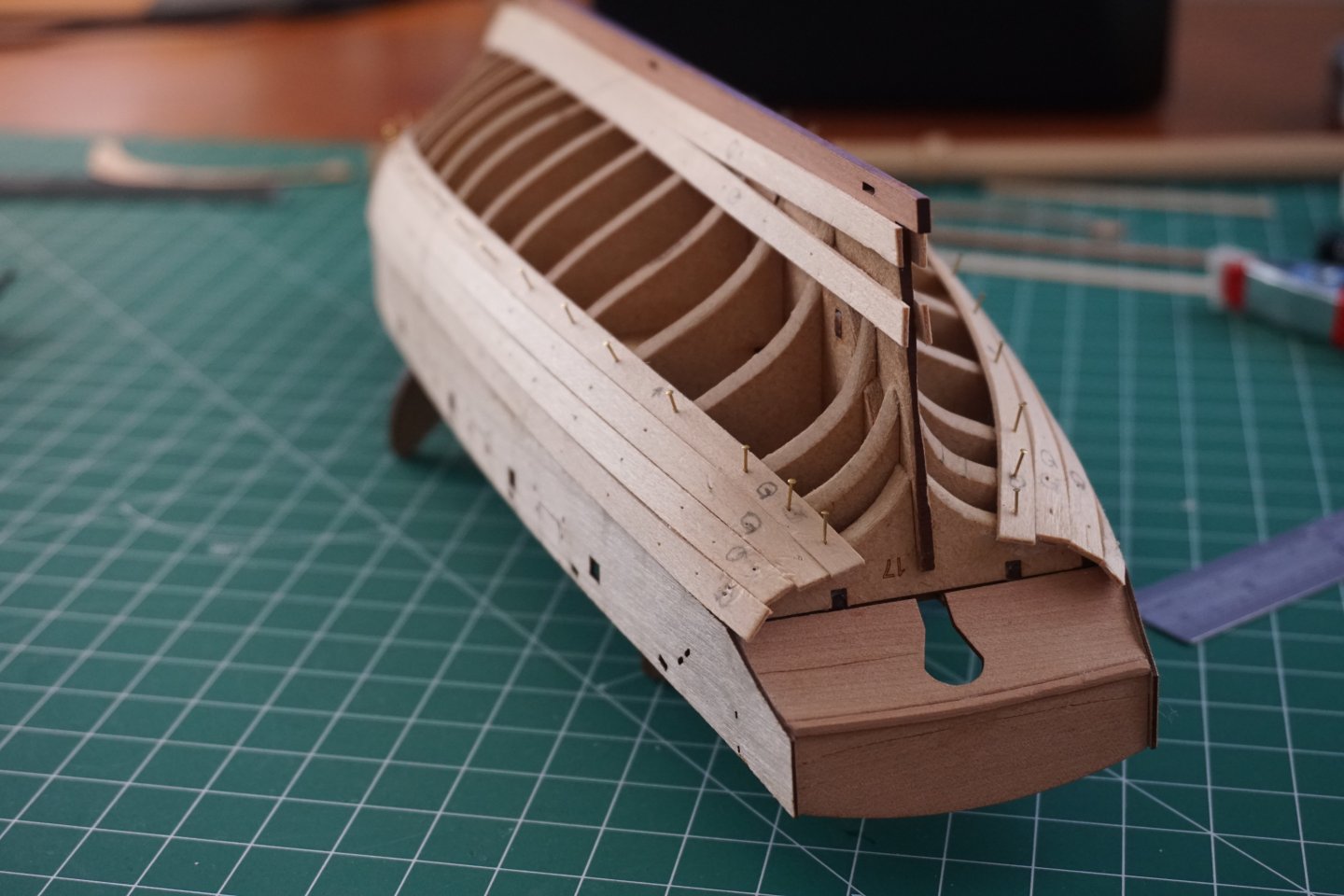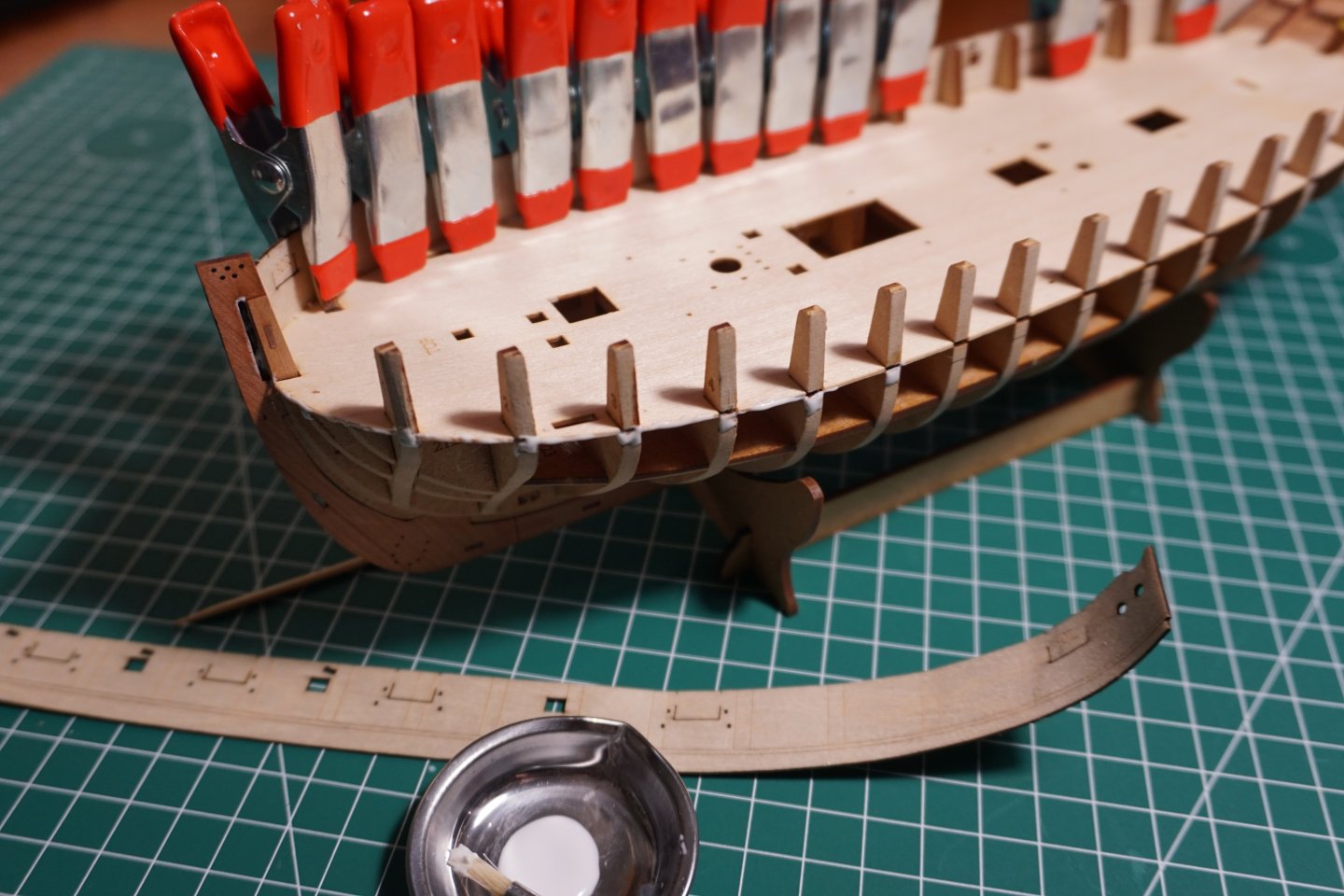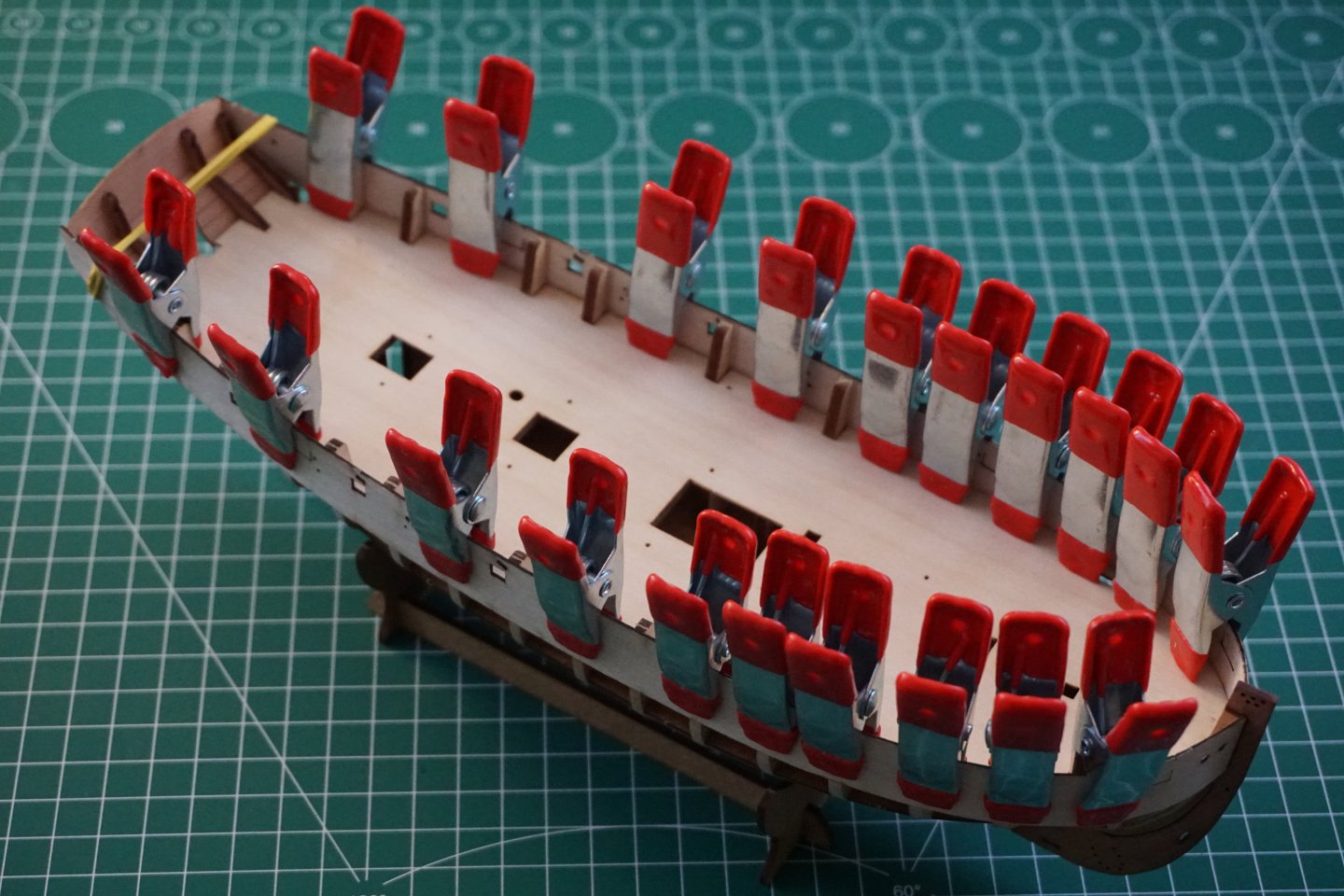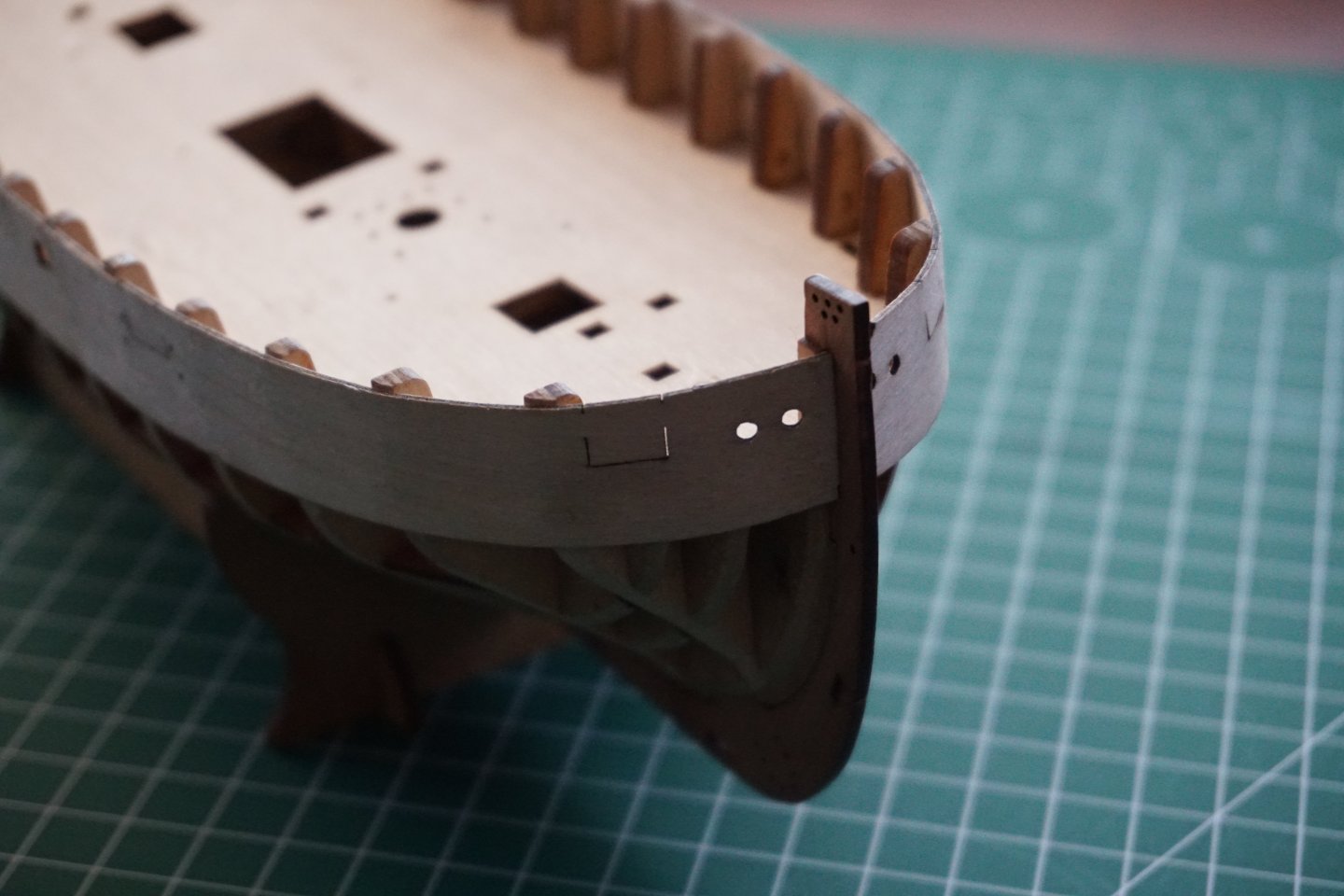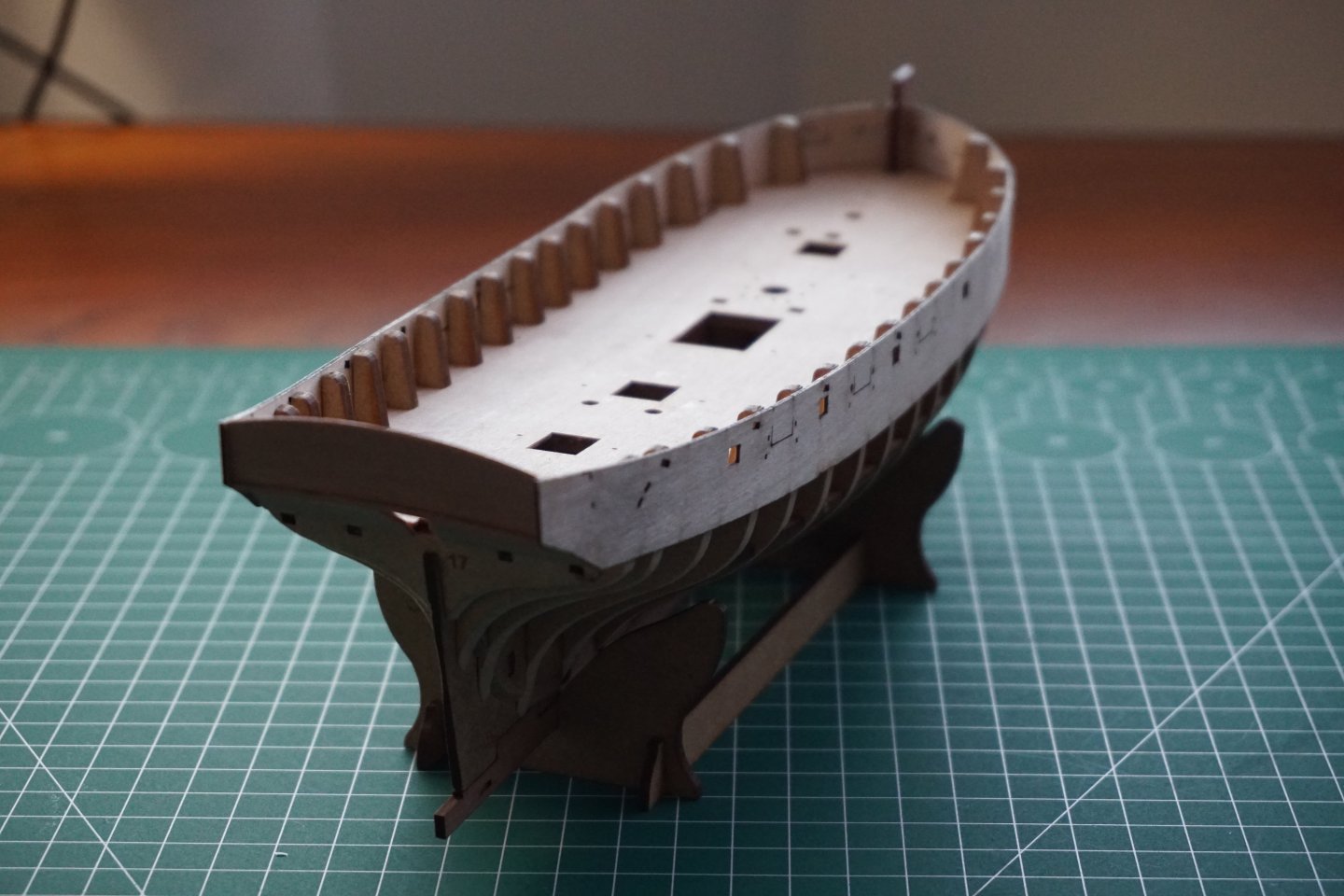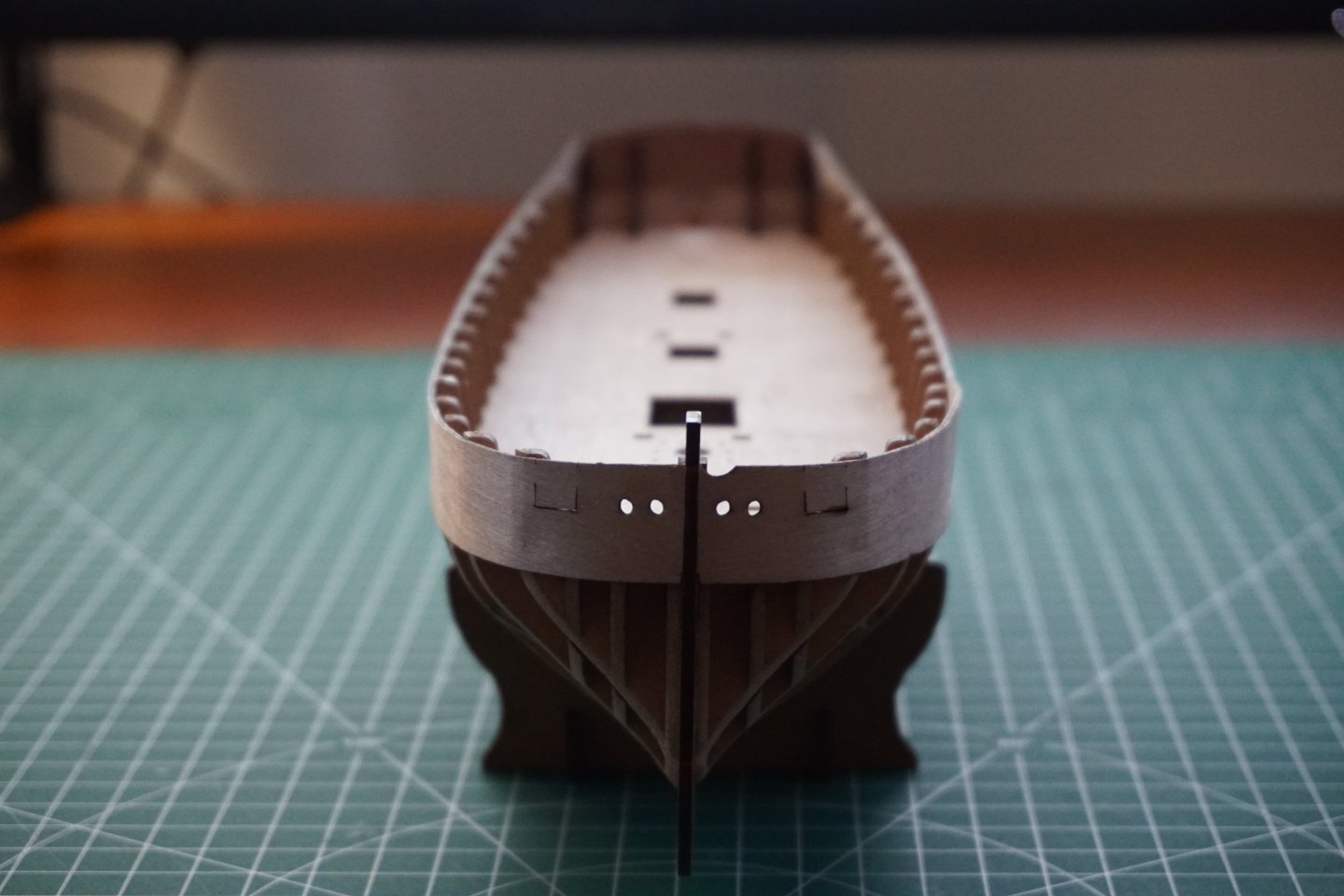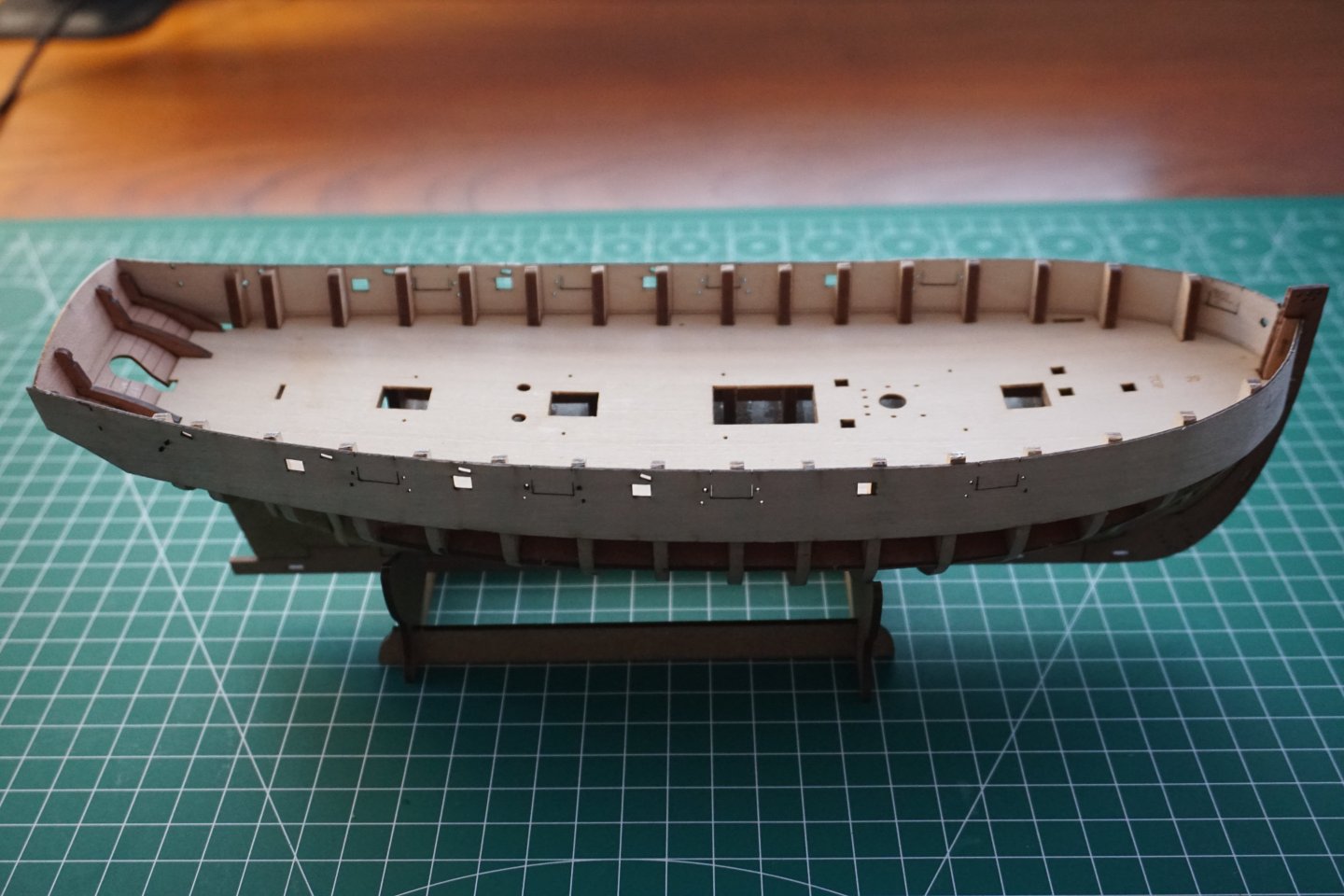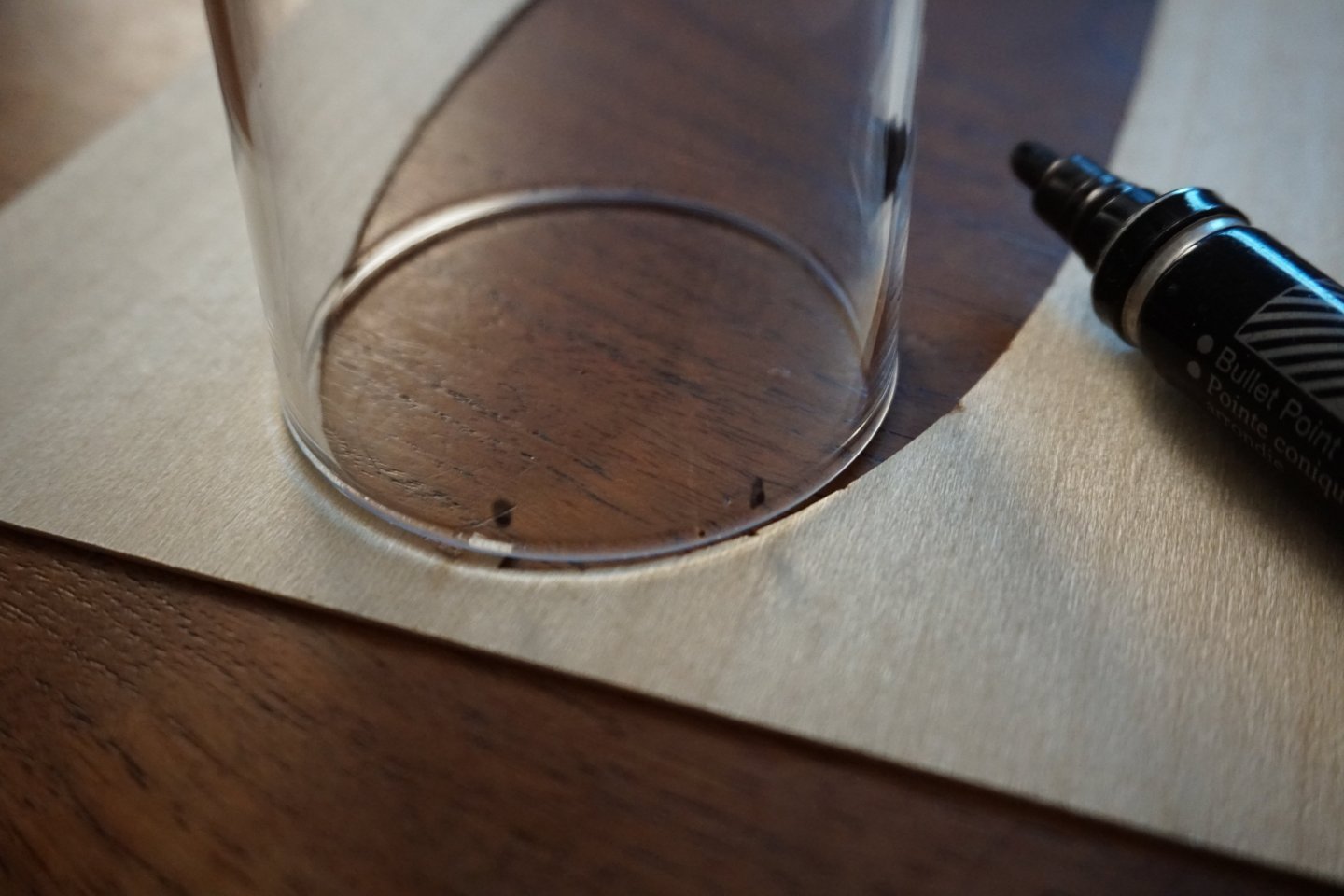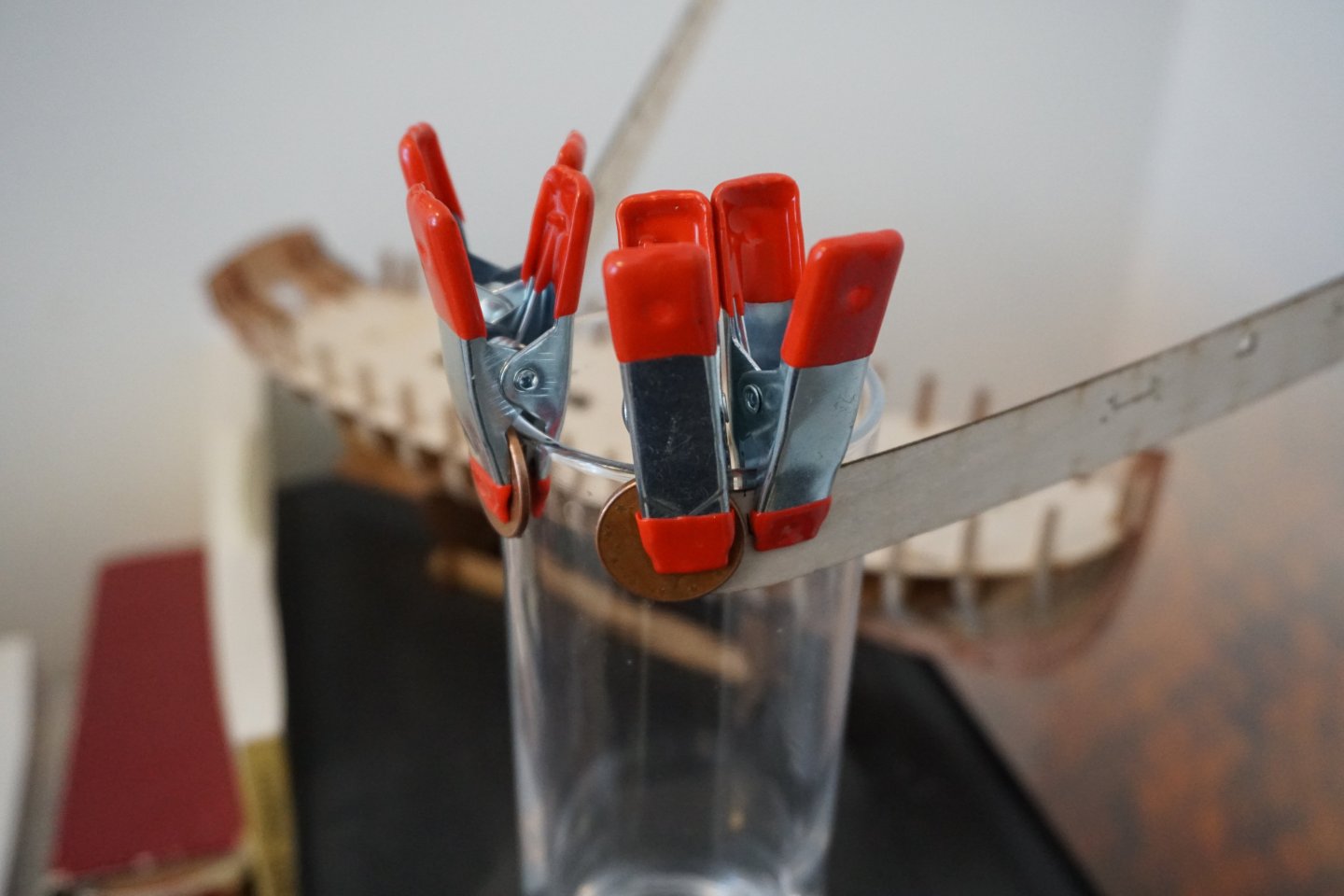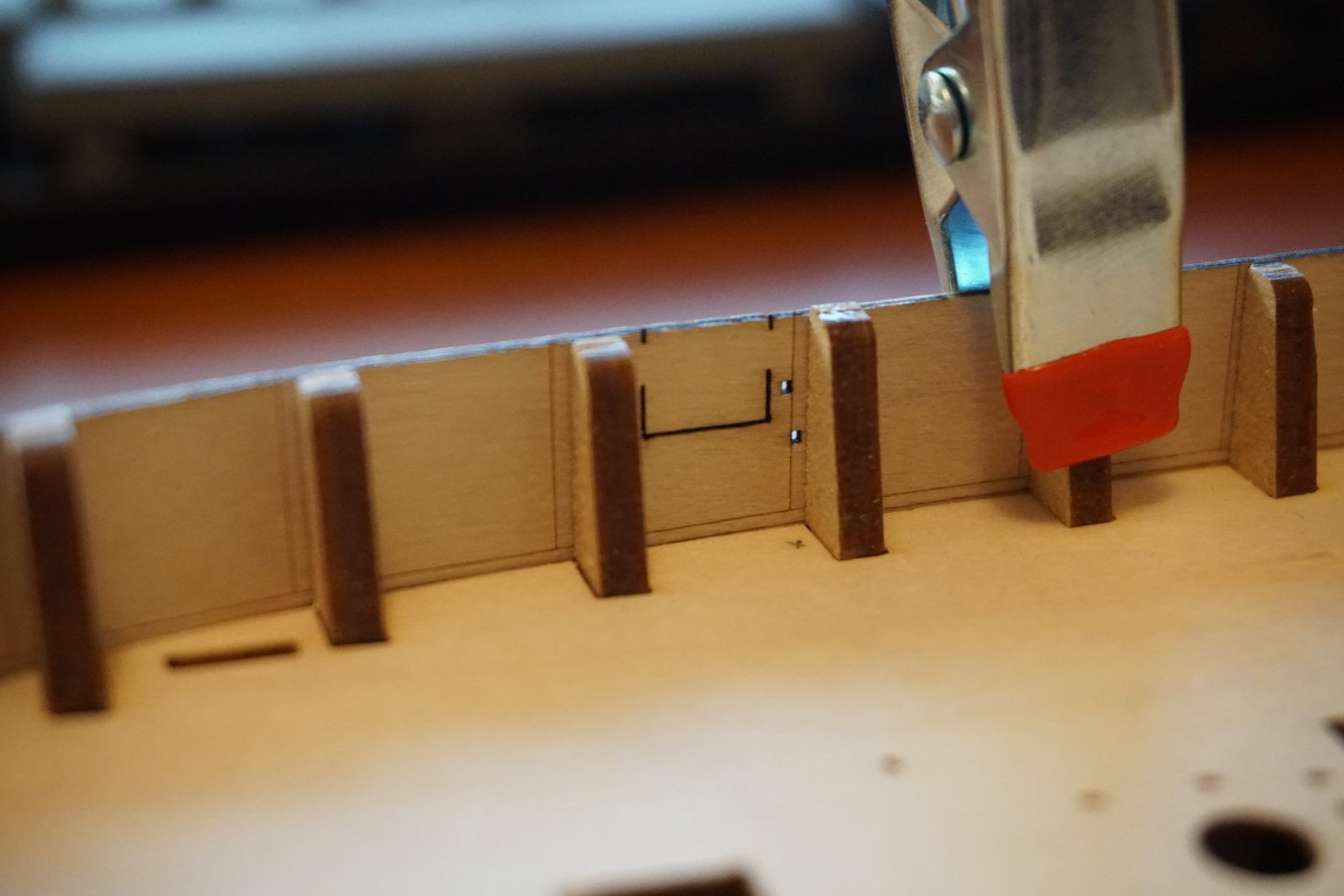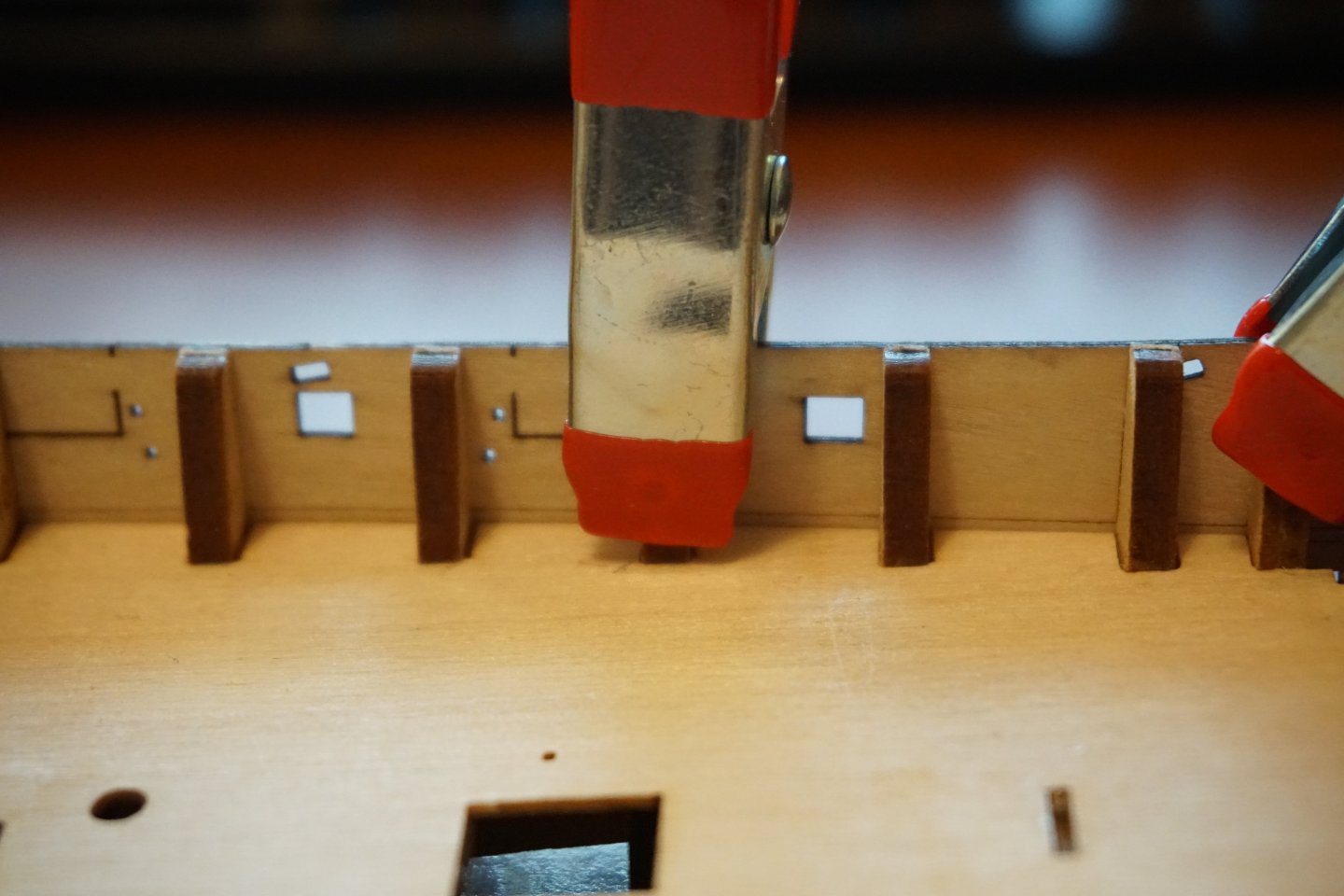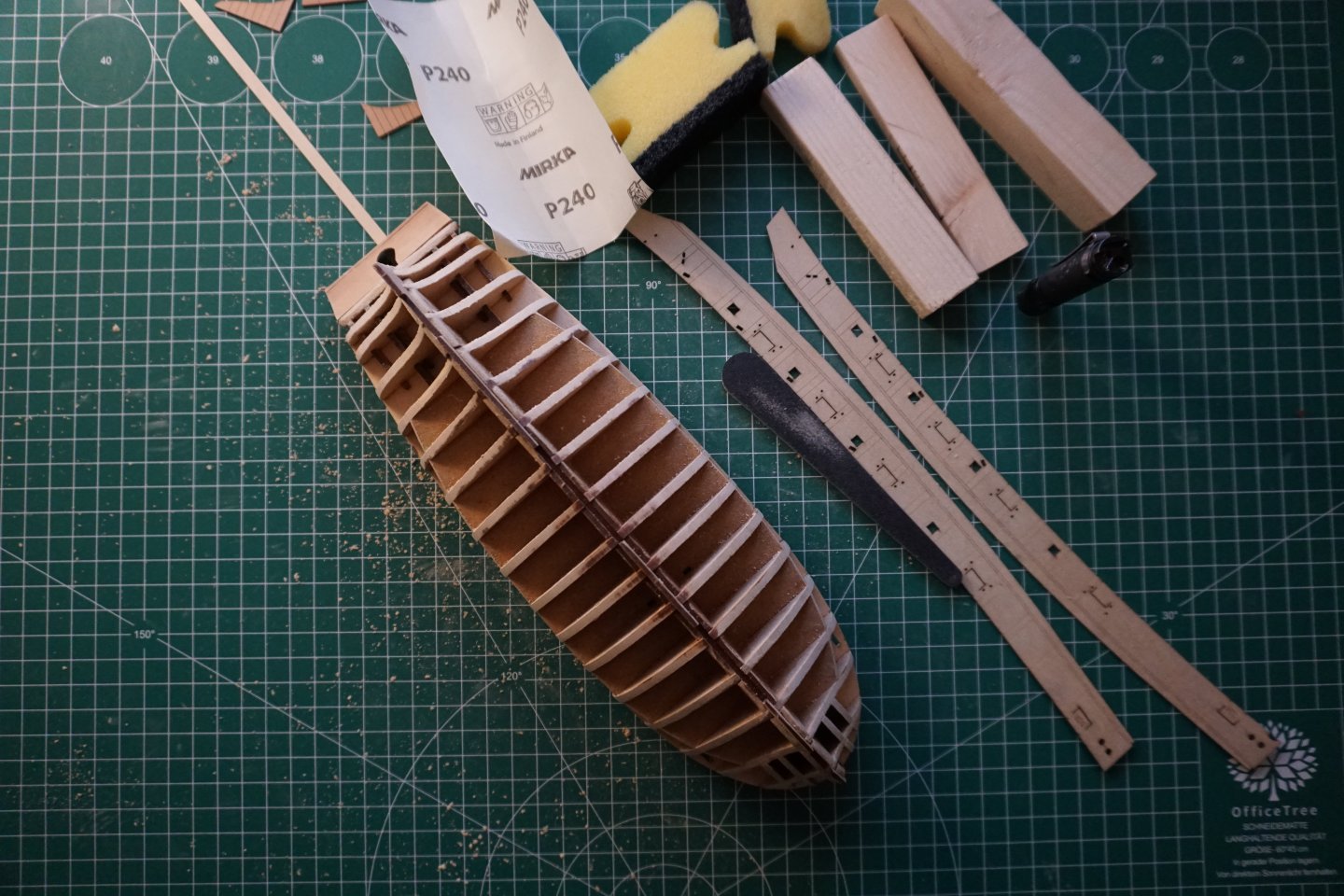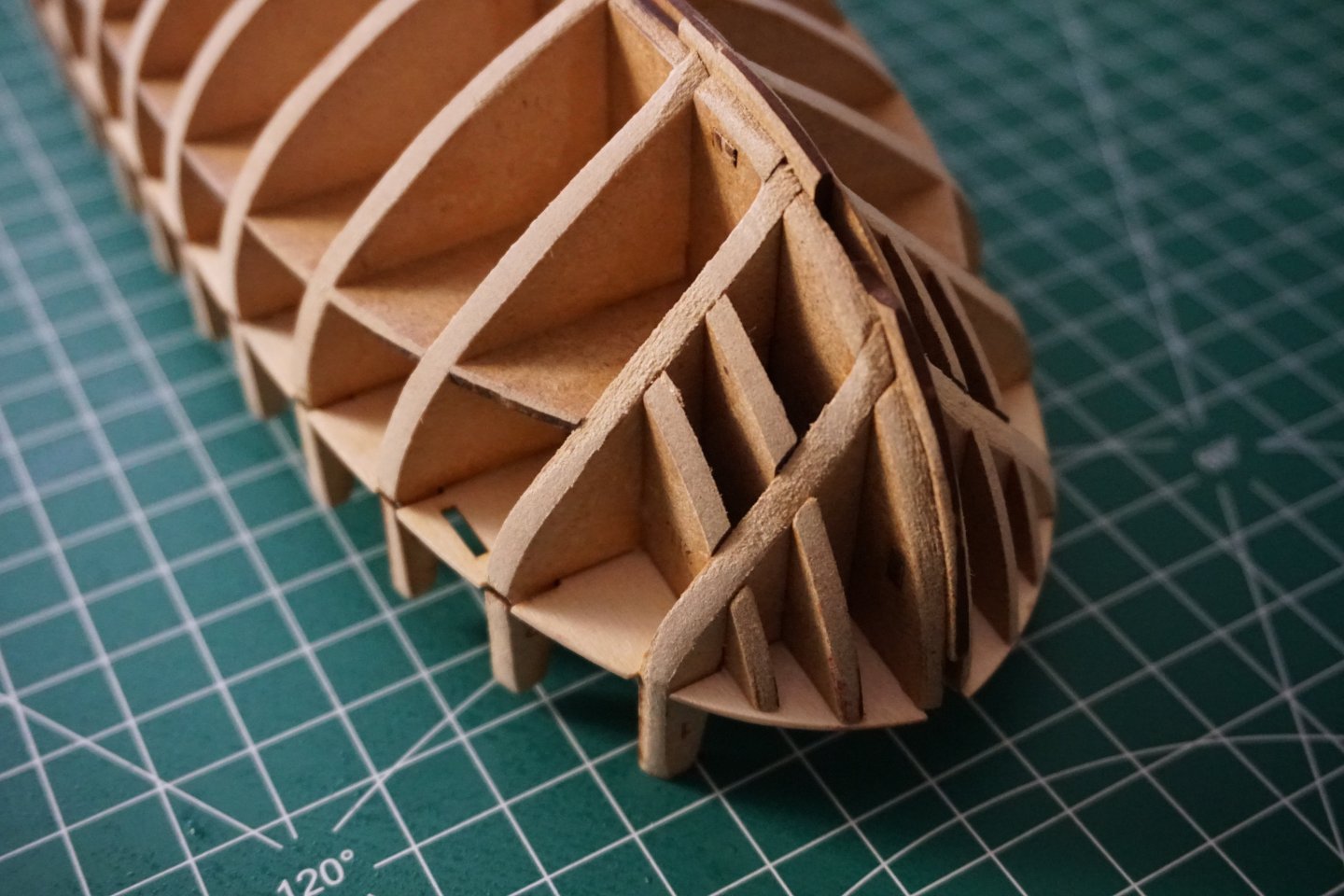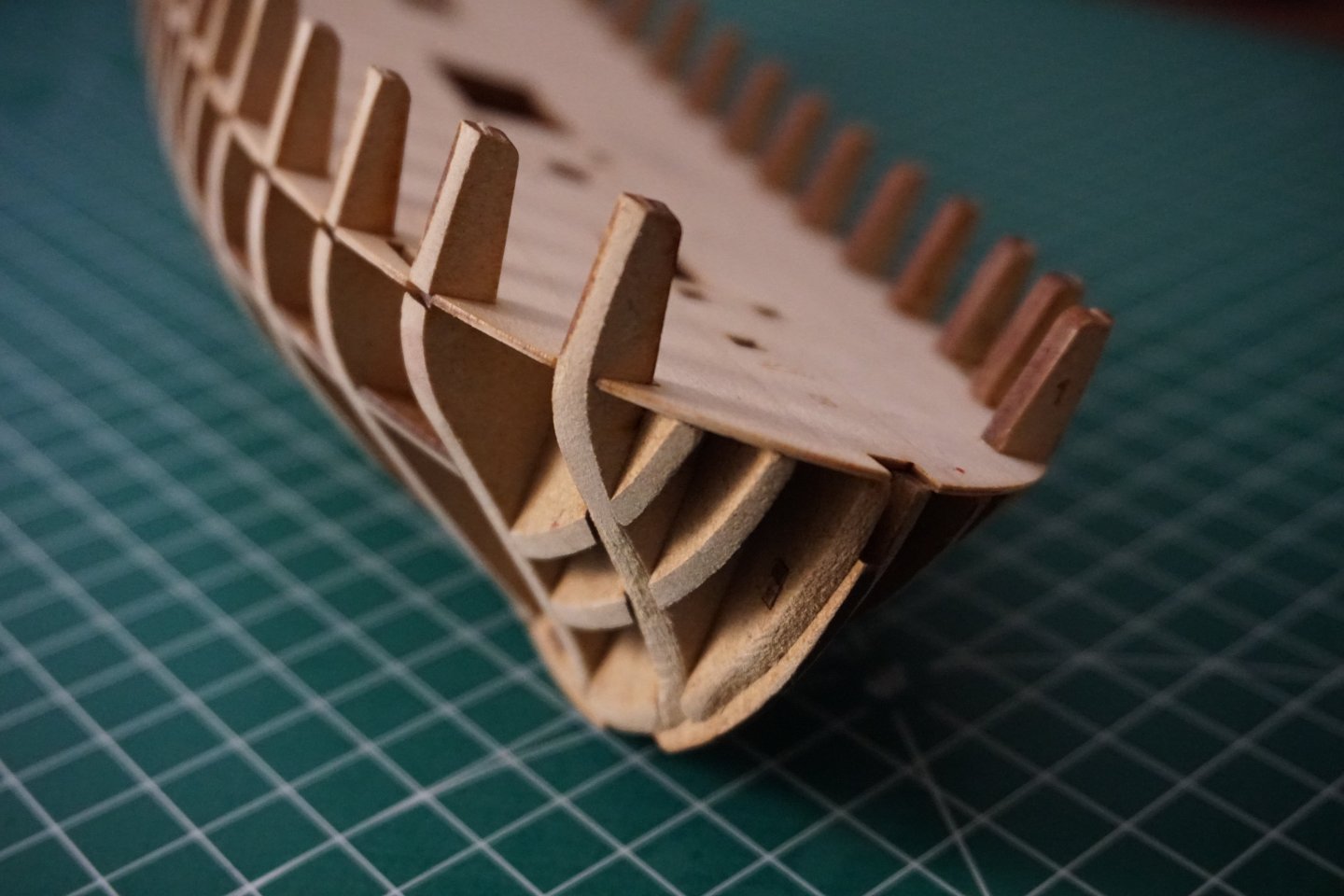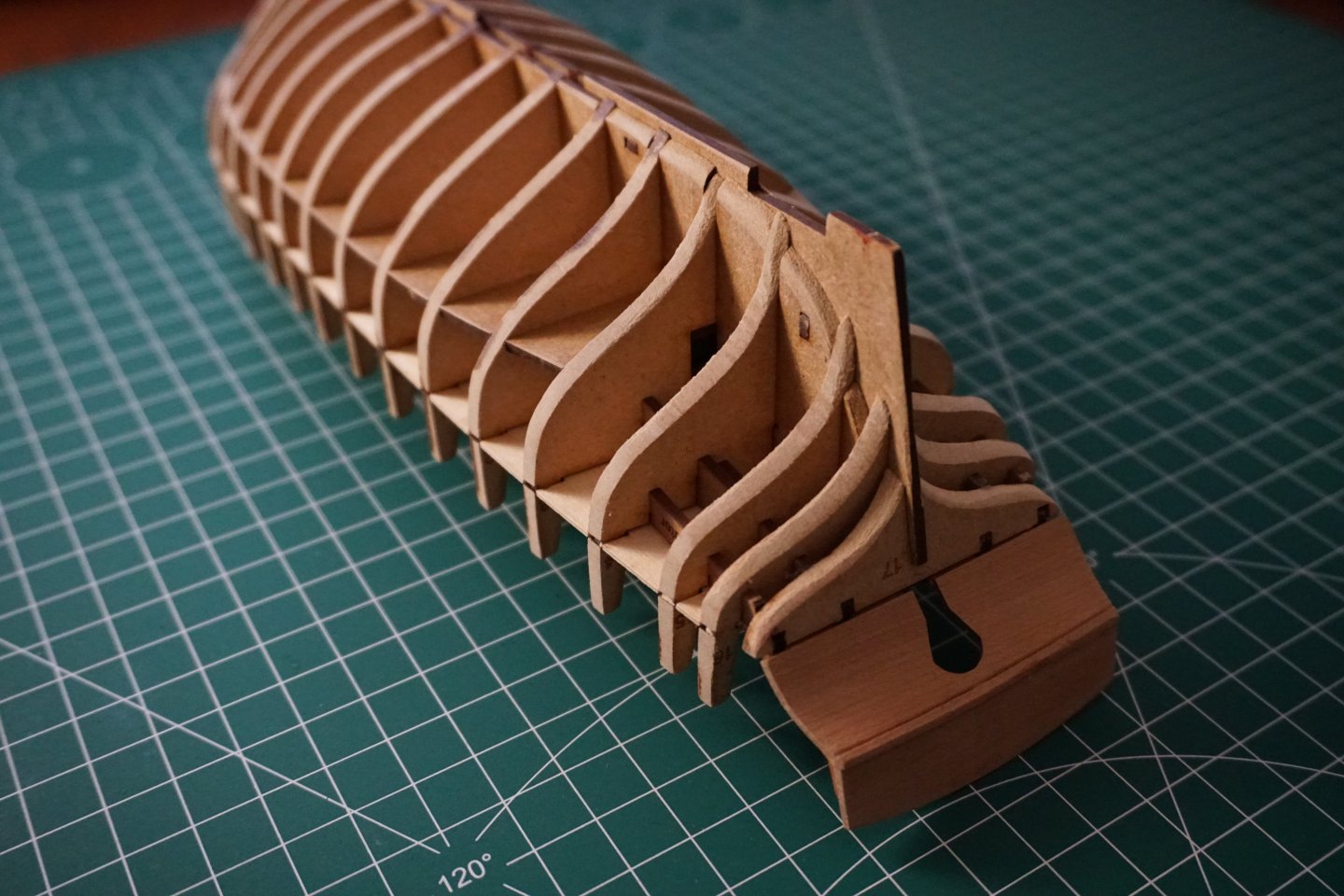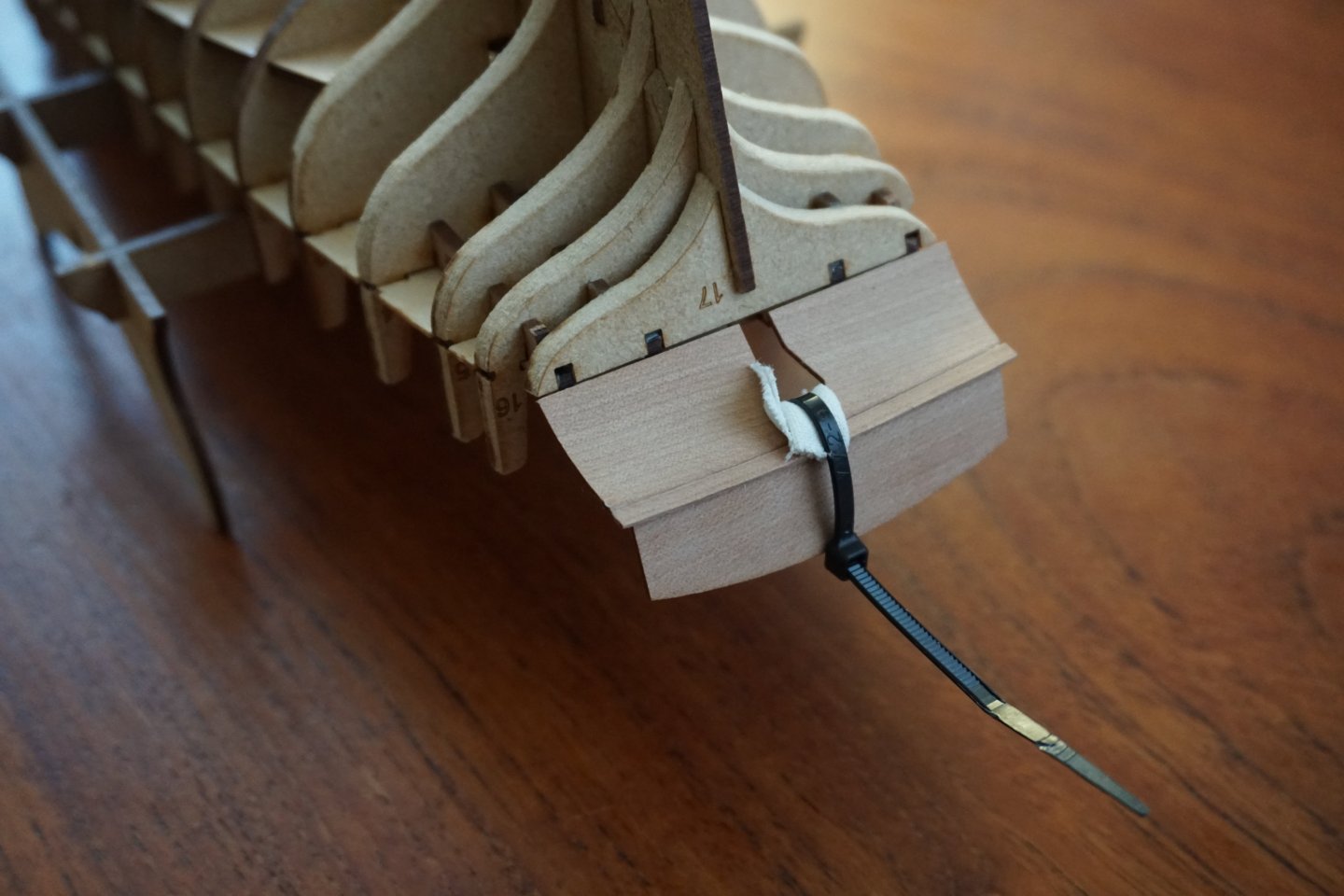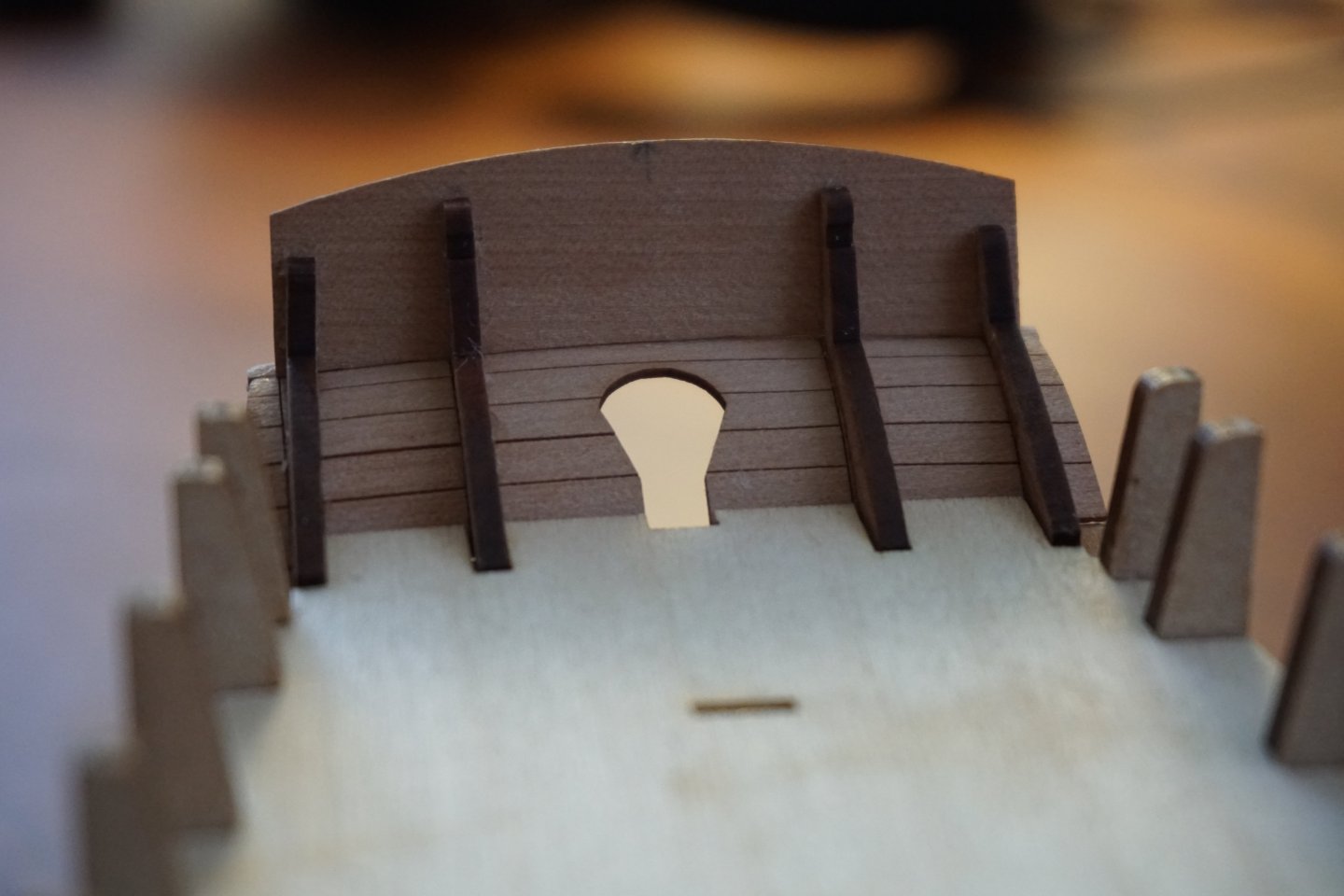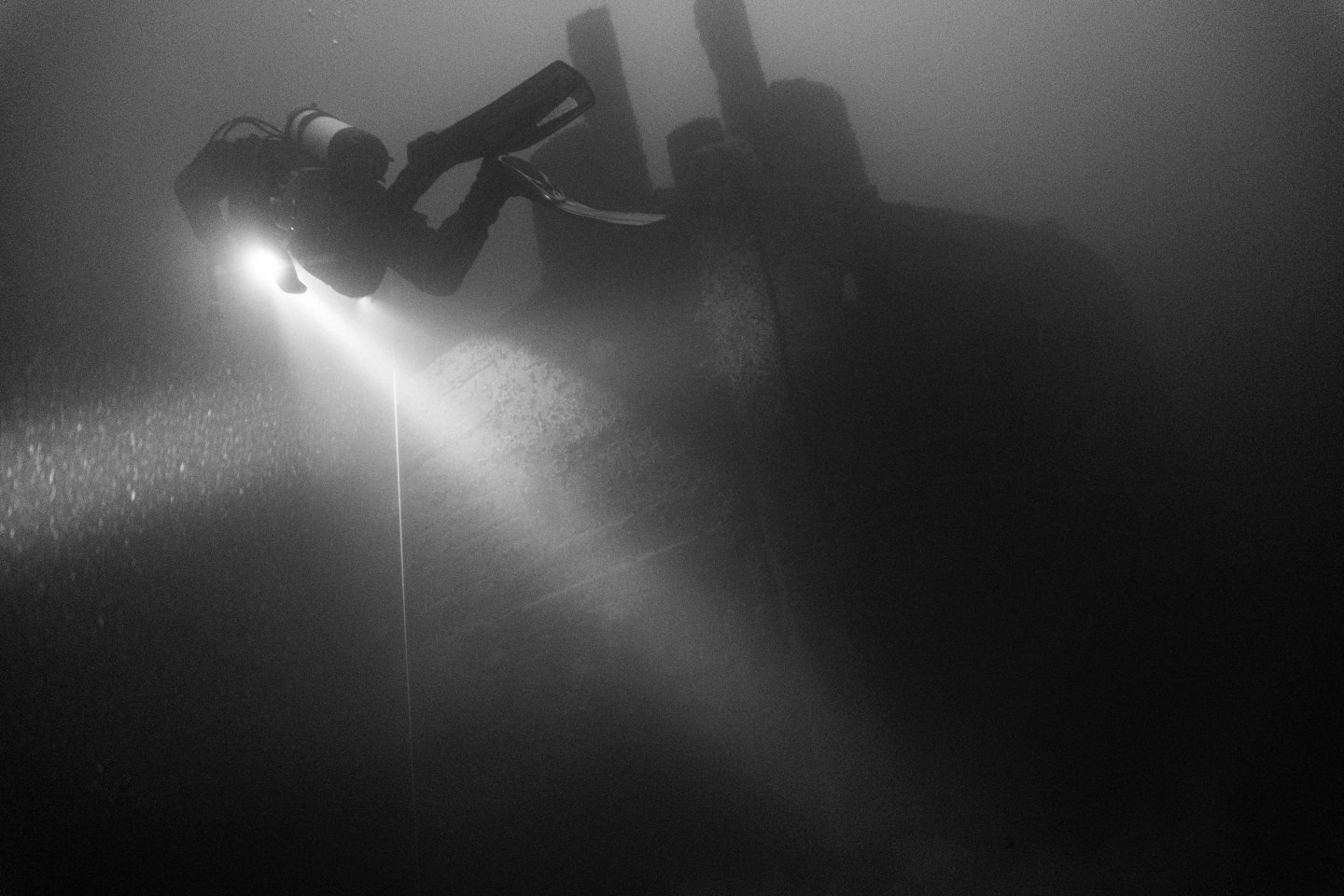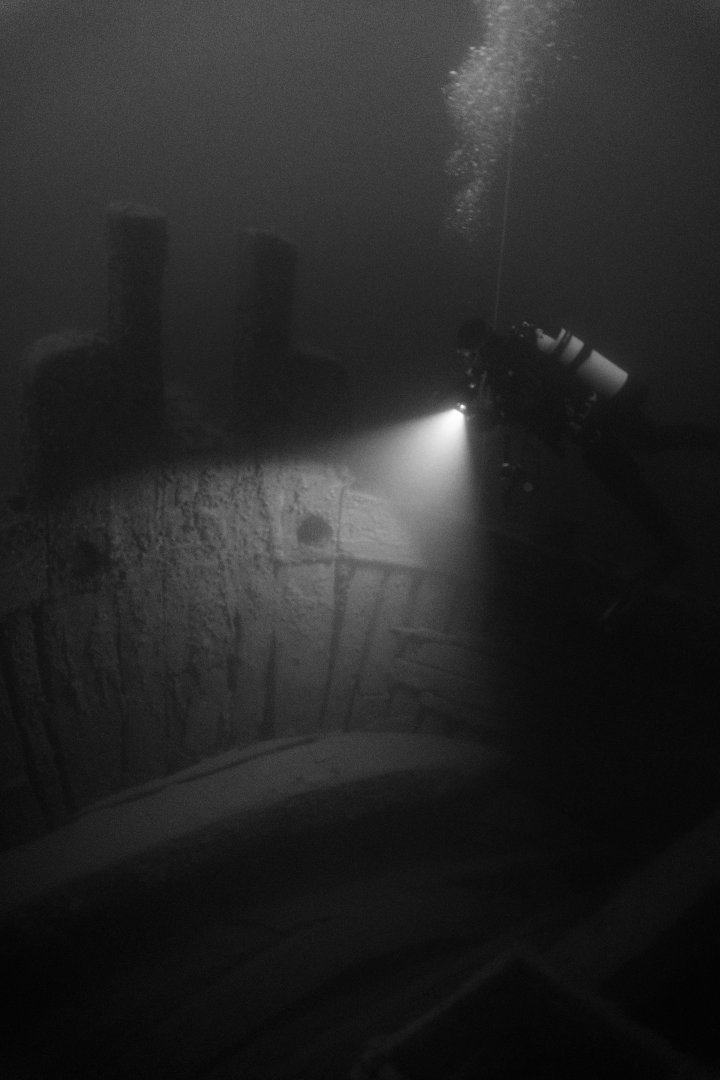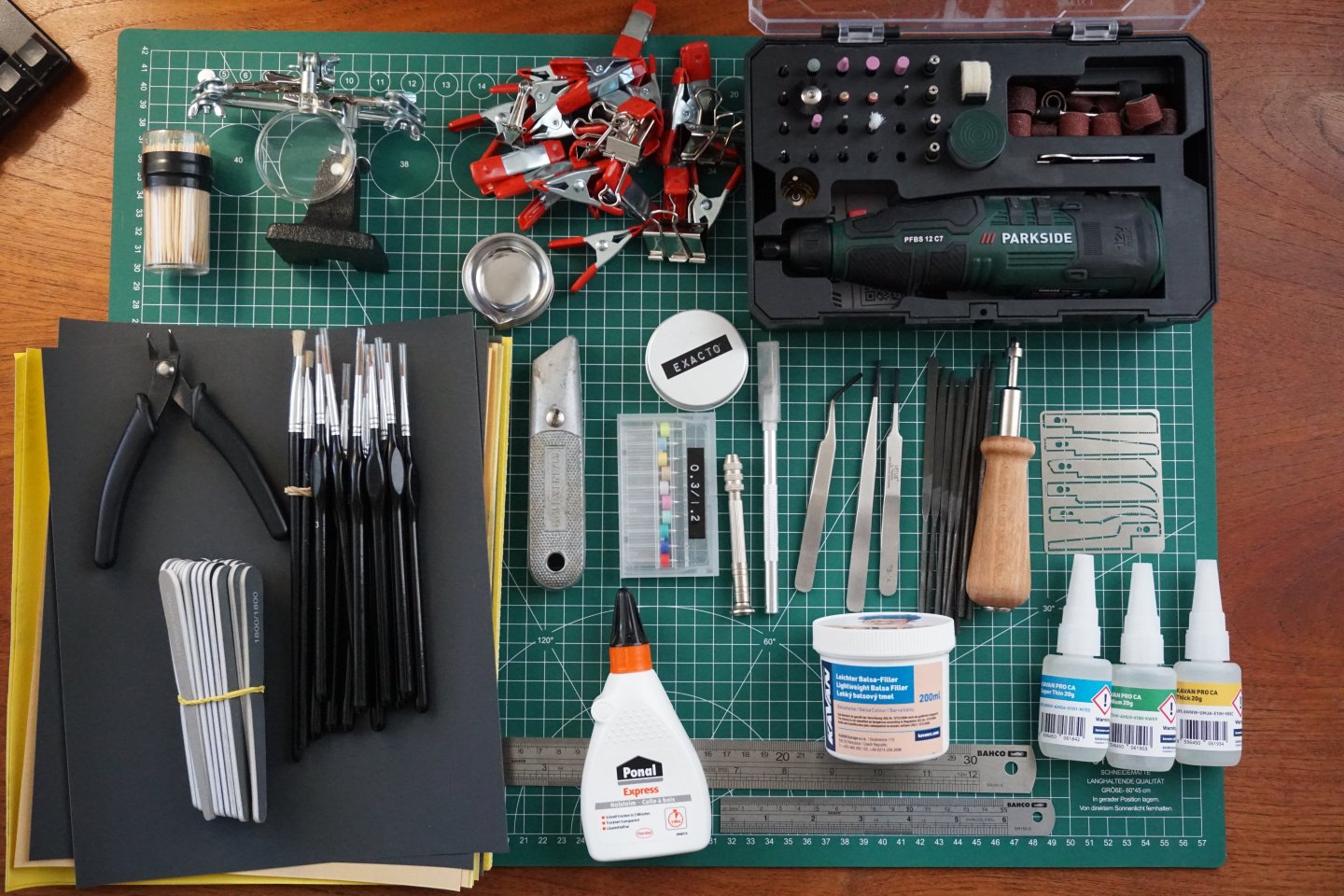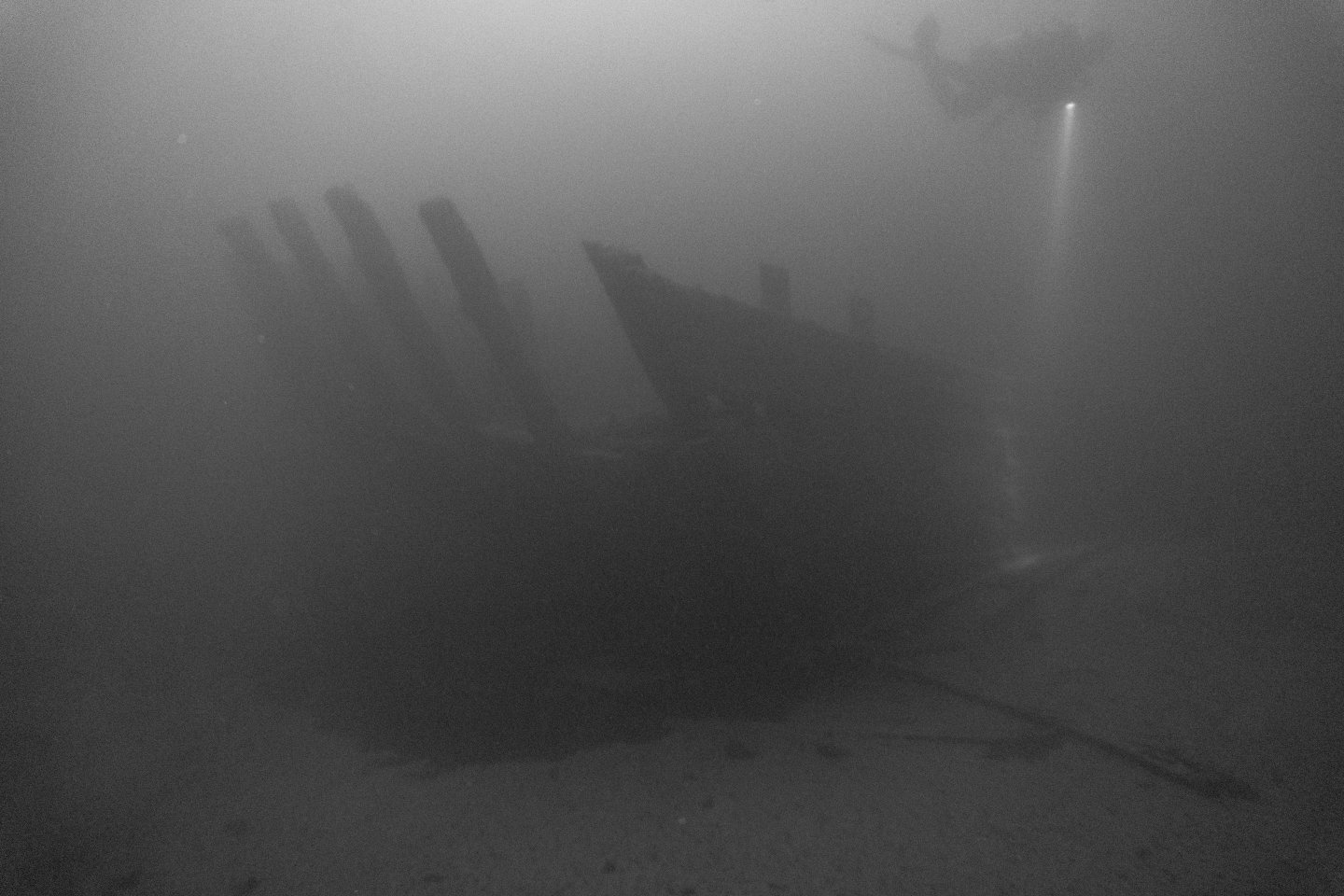-
Posts
23 -
Joined
Content Type
Profiles
Forums
Gallery
Events
Everything posted by Nightdive
-
Wow, it sometimes takes a while for parcels to arrive from the UK. In the meantime I started another side project, creating some lighting with an Arduino. I'm planning to place one or two leds below deck, plus one on the deck, but as the Sherbourne doesn't have any fixed lights, I decided to create a portable lantern. I used HMS Victory's lanterns as a model, with dimensions sourced from this website: https://www.invaluable.com/auction-lot/a-painted-tin-and-horn-lantern-from-the-gun-decks-c-ce640afa9a It's made of 3 mm acrylic rod, electrical tape, shrink tube for the horizontal bands, plus some paint and scrap brass. 2025-10-30.mp4 edit: After making my post, I realized that the top part looked a little off. So I went back and removed an extra piece of brass from underneath the loop.
- 52 replies
-
- First build
- Cutter
-
(and 2 more)
Tagged with:
-
While waiting for the paints, I started working on the display case. It's mainly alder, which I'll stain later (test piece in the lower right corner). The baseboard is a glued beech panel, and I'll probably paint it black. I've left room for a 2 mm ventilation gap around it. I plan to add some illumination to the case, so the small drawer is for batteries. I'll replace it with a solid panel, if I abandon my lighting plans.
- 52 replies
-
- First build
- Cutter
-
(and 2 more)
Tagged with:
-
That's awesome, welcome to the hobby! With my limited experience, I actually find scale modeling and scuba diving to share some similarities. Everything is about careful planning, calm execution, and if you're breaking a sweat, you're probably doing something wrong! I started diving at 16, but then forgot about it for well over a decade. For the past 10 years I've been mainly diving shipwrecks in the Gulf of Finland with my old high school buddy. The wrecks are fantastic, but the water is always freezing cold, and visibility is often poor. I wish there was a place with the visibility of the Great Lakes, combined with the variety of intact shipwrecks dating back hundreds of years that the Baltic Sea has. Most of my favorite wrecks are actually from the Sherbourne's era. It's crazy to go down the mast of a merchantman that sank sometime in the late 1700s, and see all of the items where the crewmen left them all those years ago. Sometimes even coils of rope survive.
- 52 replies
-
- First build
- Cutter
-
(and 2 more)
Tagged with:
-
Below-waterline painting completed, time to celebrate a little. After two layers of acrylic, I opted to touch up the seams with a brush. I lost count of how many airbrushed layers of paint I applied, but before the final two ones I attached the PE parts with CA. Too much CA in fact, some of the depth markings had to be removed, bathed in acetone, and re-primed. I think that there is a nice amount of woodwork still visible. I would have preferred more consistent lines of planking, but for a first model it's close enough to the real thing: I have to take a break from modeling now, as I'm waiting for Cornwall Model Boats to restock Admiralty Paints' yellow ochre and 5x5 mm walnut strips. The strips are for a little slipway that I'll try to build for the finished ship, inspired by these models: https://nauticalhistory.weebly.com/the-70-gun-third-rate-prince-frederick-of-1714.html
- 52 replies
-
- First build
- Cutter
-
(and 2 more)
Tagged with:
-
Thanks @palmerit, I used a tiny bit of filler at the bow, but think I'll leave the plank seams alone at this point. We'll see where it goes after a couple of coats of acrylic. I also decided to prime the PE parts separately and add them later, their details might become cluttered by paint if added at this point.
- 52 replies
-
- First build
- Cutter
-
(and 2 more)
Tagged with:
-
Thank you again! Your build logs and tips have helped me reach this point in the build. The hull is now primed, but some of the gaps seem a bit large. Do you think that I should use some watered-down filler, or will layers of top coat and sanding in between be enough? I'd prefer planking to be visible in the finished model, so I'm concerned that using filler might be too much.
- 52 replies
-
- First build
- Cutter
-
(and 2 more)
Tagged with:
-
Thank you for your likes and comments, everyone! The Sherbourne is now sanded, filled, and ready to be painted - if the weather permits - later this week. My plan is to seal the wood with Tamiya fine surface primer, sand if necessary, add the photo-etch parts, prime those parts, and then apply as many coats of AK off-white as needed.
- 52 replies
-
- First build
- Cutter
-
(and 2 more)
Tagged with:
-
As I got to this point in the planking, I noticed that there was a 2 mm difference in the remaining gaps. I could finish the port side with 15 planks, but the starboard would require 16. So initially I split my spreadsheet in two and had elaborate plans about heavily thinning and tapering all eight remaining planks. But after shaping the first one, I understood how laborious it would be and decided to just finish both sides identically with three planks each, then add a small filler piece to the starboard side. And with that, the second planking was done. While everything I learned during the first planking certainly helped a lot, I think the second layer was easier in general, as there was almost no need to twist planks over a kettle in multiple spots.
- 52 replies
-
- First build
- Cutter
-
(and 2 more)
Tagged with:
-
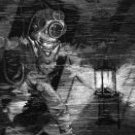
HMS Falken - little sister of HMS Wasa
Nightdive replied to Nirvana's topic in Nautical/Naval History
https://sketchfab.com/3d-models/shipwreck-uunihylky-varmbadan-kirkkonummi-9e3320db5a2c45faa24f414b68799421 Before its identification, the Falken was known as the 'Stove Wreck' due to a large brickwork stove found within it. It has been a well-known dive site since its discovery in 1974. The details of her loss remain unknown, but due to her shallow location (above 9 m/30 ft), it has been speculated that she was intentionally grounded to allow some salvage of her cargo. I planned to dive it and other wrecks in the area last summer, but the weather didn't permit on the days that we had set aside. -

Damaged model, looking for the original details on it
Nightdive replied to Kevin Kenny's topic in Wood ship model kits
The visually closest one I could find is the SS Peruvian of the Allan Line. Could very well be some other migrant ship of that era. -
I'm now past the halfway point on the second planking and have been able to get away with fairly little clinker. I've used @Jase's spreadsheet method and re-measured after every few planks. Only some small adjustments to the spreadsheet have been needed. I've primarily used PVA again, with some CA for the bow and stern.
- 52 replies
-
- First build
- Cutter
-
(and 2 more)
Tagged with:
-
Excellent information, thank you for taking the time to write your posts. @ERS Rich interesting point about sealing, as a beginner, I assumed that harder woods should just be airbrushed directly. I've been meaning to mix some shellac from dewaxed flakes to touch up some old shellacked furniture scratches, Sherbourne will give me the perfect reason to finally do it. There's also plenty of extra wood in the kit, and that will give me a chance to experiment with different methods before doing the final painting. @palmerit I've already gone ahead and purchased an airbrush, though it is a fairly inexpensive hardware store one. I haven't tested it with paint yet, and I'll keep your Iwata and Badger recommendations in mind if it turns out to be of low quality. I was hoping to do all my painting outside, but it's getting late in the year. I might have to purchase one of those cabinets for later stages of the build. For compressed air I've decided to use a scuba tank. It should work well, the air is already bone dry. The adapters and a small additional pressure regulator cost only a fraction of a compressor's price. For fun, I'll post a picture of the setup once I get to the painting phase. @Desertanimal @palmerit Good point about blackening. I was already opting to do it for companionway hinges and belaying pins, but just as with hardwood, I assumed that PE can also be painted directly. My local hobby shop seems to carry Tamiya primer too, so I'll use that one in case I decide to paint the below-waterline brass parts white.
- 52 replies
-
- First build
- Cutter
-
(and 2 more)
Tagged with:
-
Thank you for the encouraging comments! I hope that the second planking goes well too. Sanded with 180 grit paper. I also used a little bit of filler at the bow to ensure a snug fit for the second layer of planks. I have some thoughts and questions about paints, as I need to order them soon, and I'd appreciate your opinions. This is completely new to me, so I've done some research by reading older discussions on this site. If I've understood correctly, there is no single correct mix for the ochre paints or the "white stuff". The colours varied in real life, and it's ultimately up to the modeler's taste. So I've decided to go for more muted colours for scale effect, plus it looks better to my eye in other models. My current paint selection is Admiralty Paints’ red ochre for inner bulwarks, AK off-white for the white stuff, and AK smoke black for wales. I originally wanted to paint the sides with Admiralty Paints' yellow ochre. It seems fairly close to HMS Victory's current colour scheme, which I like personally, and it could be a nice little nod to the connection between these two ships. However, after looking at these contemporary cutter models, I'm no longer so sure about painting the sides at all. In this thread, it was mentioned that yellow or red sides were mandated by the Navy Board in 1777, so I suppose it's theoretically possible that the Sherbourne was painted yellow in the last years of her career. My question is, if I choose to paint the parts, can they be thinly airbrushed so that the lasered details will remain visible? Also, would it be historically inaccurate to paint the depth markings, horseshoe and stern fish plate white at the same time as I airbrush the hull?
- 52 replies
-
- First build
- Cutter
-
(and 2 more)
Tagged with:
-
First planking done! It took some measuring and planning, but I was able to finish it without creating terribly irregular last planks.
- 52 replies
-
- First build
- Cutter
-
(and 2 more)
Tagged with:
-
Hello everyone, I'm back after a break from modeling for other projects. To be honest, I also kept procrastinating this step, as I knew that planking would be a challenge. I'm twelve planks in and it seems to be going fairly well so far. I've roughly followed the planking method that Jase presented in his Sherbourne video series; starting from the centre, marking the spot where the plank starts to overlap the previous one, then beveling the plank from that point onward. Chuck Passaro's planking videos and GlennUK's very detailed Sherbourne build log have also been very helpful. I've beveled the first two planks by 2.5 mm and the next two by 2.0 mm. Everything has been glued with PVA with CA only for the last bulkhead (no. 17). There is more clinker effect in the bow than I had hoped for. I need to step up my edge-bending game for the second planking.
- 52 replies
-
- First build
- Cutter
-
(and 2 more)
Tagged with:
-
Thanks JC, I'm trying to be meticulous, especially at this point of the build, since as a new modeler I don't yet know what sort little errors will cause major issues later on. Still need to learn patience and how to handle the model more carefully, I too managed to break part of the stern. The starboard counter cracked in half when fitting the bulwarks. Luckily it was along the laser etched line, so it can't really be seen from the side that matters. I'm glad that it is now sandwiched in between the bulwarks for some protection. I did pretty much this, and concluded that it's probably fine as long as the gun ports and other features are identically located on both sides. There was also only about 1 mm of extra bulwark on both sides of the stern, so I can't be too far off. Doing any extra sanding wouldn't have fixed anything, only moved the point where the bulwarks didn't match the etched lines, and made the hull shorter. Those tutorials by ModelKitStuff have been useful, I've also binged Tagliamare's videos on the Sherbourne. After many dry fits I glued the bulwarks on, let them cure for 24 hours, and then brushed some watered down PVA from below. Looks pretty good to me. Now, onto planking.
- 52 replies
-
- First build
- Cutter
-
(and 2 more)
Tagged with:
-
I tried installing the bulwarks straight from the sheet, but there were some cracking sounds and I felt that there just isn't enough give. So I soaked the parts in hot water for a couple of minutes and clipped them around a drinking glass for 24 hours. I'm currently dry fitting them in place, but the bulwark tabs do not exactly fit the engraved lines. The manual said that some variation due to sanding is fine, but is this too much? There's about 1.5 millimeter difference in the bow, while the stern is perfect. It's the same in the other bulwark.
- 52 replies
-
- First build
- Cutter
-
(and 2 more)
Tagged with:
-
That sponge tip was a good one, thank you! I cut pieces from a kitchen sponge and those helped me work around the bow and the stern. The rest I sanded with blocks using 180 and 240 grit sandpaper in as long strokes as possible, following the curve of the hull. I also used one of the lime wood planks to see whether there were any bulkheads that didn't make full contact. The last one in the stern doesn't, but I was afraid to sand it any further.
- 52 replies
-
- First build
- Cutter
-
(and 2 more)
Tagged with:
-
Likewise, your log had good information about the steps that I'm just getting into. I spent today's hobby time cutting some sanding blocks from scrap wood with a table saw. I will try to do the fairing process slowly and carefully, and not replicating my previous experience of having to create filler pieces after removing too much.
- 52 replies
-
- First build
- Cutter
-
(and 2 more)
Tagged with:
-
I was going to continue this project later this week with sanding and a couple of the subsequent steps, but I became annoyed with my transom error and decided to fix it. First I debonded the inner transom with isopropyl alcohol. Then I cut a three millimeter wide strip of pearwood and glued it to the counter to act as a replacement for the bit that I had filed off. Finally I re-glued the transom in place and pulled the counter against it with a padded zip tie. I'm pleased with the result, it definitely looks better now.
- 52 replies
-
- First build
- Cutter
-
(and 2 more)
Tagged with:
-
The false deck snapped in nicely after I had dealt with the problem spots with a file. It just took me a very long time to find all of them, as I didn't want to engage the snapping mechanism until I was completely sure that it was going to be final. I softened the stern counter a bit over a kettle spout before gluing it on. I also placed some fabric pads underneath the clamps to spread pressure more evenly. Then I filed the counter flush so that I could fit the stern transom. I think I made a little mistake here, it would have been better for the counter to overlap the transom and not the other way around. Now there isn't that much of a curve on the inside where the transom and counter meet. I don't think that it is very noticeable and hopefully will be a very minor flaw in the completed build.
- 52 replies
-
- First build
- Cutter
-
(and 2 more)
Tagged with:
-
Thank you for the messages everyone, glad to be here. I made good progress on building the bulkhead yesterday, a drum sander made a quick job of beveling the parts. The rest was easy to assemble and almost all of the parts fit toghether perfectly without filing, but I did manage to snap one of the outer pearwood stern frames into three pieces. It turned out to be a tight fit and I had already applied the glue, so I tried to force it in. Bad mistake. No real harm done though, I was able to salvage the part by gluing it back together and putting it back into the pearwood sheet to cure overnight. A lesson learned about dry fitting everything, especially when I'm using the quick drying Ponal glue. I'm moving onto fitting the false deck, seems that it needs some light filing, especially as it is so thin.
- 52 replies
-
- First build
- Cutter
-
(and 2 more)
Tagged with:
-
Greetings all! I've had a lifelong interest in the sea, ships and maritime history, and building some sort of a ship model has been in the back of my brain for a decade or more. Late last summer I was given an old and battered model of a full-rigged ship, perhaps from the 1960's or so, and repairing her finally gave me the spark to make my first proper foray into modeling. While looking for a beginner friendly model I originally decided on Amati's Lady Nelson, but on some level I was bothered by it not being based on a real ship. Fortunately I kept browsing and eventually stumbled on Vanguard Models' Sherbourne, which seemed perfect. The kit arrived a bit over a month ago now, but I needed to order some basic tools, glues and such to get started. I still need to decide on an airbrush and paints, but that can wait until later, as it is going to continue to be too cold to paint outside for a few months. I've taken the time to study the manual - which is very detailed, and various build logs on this forum, not only of the Sherbourne, but also other ships of the time period. If this build goes well and modeling feels like a hobby for me, I'd like to advance on to a bigger kit, maybe Vanguard's HMS Sphinx. I'm also toying with the idea of eventually building PoF models of some of the wrecks that I've been diving in the Baltic Sea. Maybe similar to this model of the Swedish ship Svärdet and the wreck models at the Vasa museum. I look forward to starting the build process soon and returning with my first updates!
- 52 replies
-
- First build
- Cutter
-
(and 2 more)
Tagged with:
About us
Modelshipworld - Advancing Ship Modeling through Research
SSL Secured
Your security is important for us so this Website is SSL-Secured
NRG Mailing Address
Nautical Research Guild
237 South Lincoln Street
Westmont IL, 60559-1917
Model Ship World ® and the MSW logo are Registered Trademarks, and belong to the Nautical Research Guild (United States Patent and Trademark Office: No. 6,929,264 & No. 6,929,274, registered Dec. 20, 2022)
Helpful Links
About the NRG
If you enjoy building ship models that are historically accurate as well as beautiful, then The Nautical Research Guild (NRG) is just right for you.
The Guild is a non-profit educational organization whose mission is to “Advance Ship Modeling Through Research”. We provide support to our members in their efforts to raise the quality of their model ships.
The Nautical Research Guild has published our world-renowned quarterly magazine, The Nautical Research Journal, since 1955. The pages of the Journal are full of articles by accomplished ship modelers who show you how they create those exquisite details on their models, and by maritime historians who show you the correct details to build. The Journal is available in both print and digital editions. Go to the NRG web site (www.thenrg.org) to download a complimentary digital copy of the Journal. The NRG also publishes plan sets, books and compilations of back issues of the Journal and the former Ships in Scale and Model Ship Builder magazines.

